上海交通大学外科学(骨外科)2009年考博真题考博试卷
- 格式:doc
- 大小:40.50 KB
- 文档页数:2
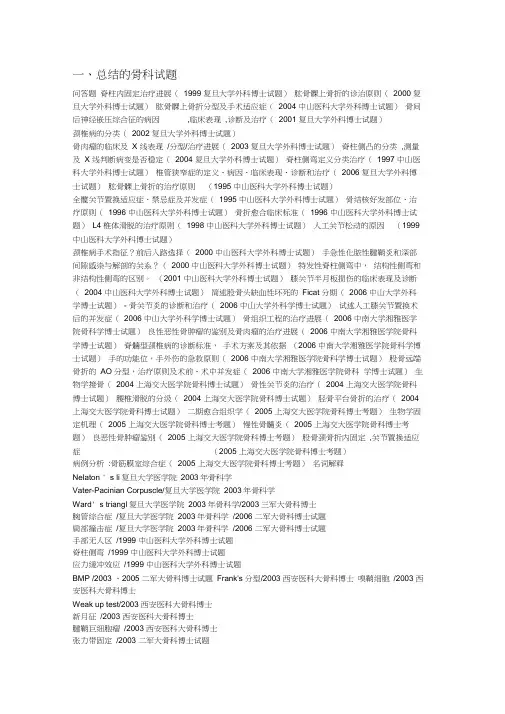
一、总结的骨科试题问答题脊柱内固定治疗进展(1999 复旦大学外科博士试题)肱骨髁上骨折的诊治原则(2000 复旦大学外科博士试题)肱骨髁上骨折分型及手术适应症(2004 中山医科大学外科博士试题)骨间后神经嵌压综合征的病因,临床表现,诊断及治疗(2001 复旦大学外科博士试题)颈椎病的分类(2002 复旦大学外科博士试题)骨肉瘤的临床及X 线表现/分型/治疗进展(2003 复旦大学外科博士试题)脊柱侧凸的分类,测量及X 线判断病变是否稳定(2004 复旦大学外科博士试题)脊柱侧弯定义分类治疗(1997 中山医科大学外科博士试题)椎管狭窄症的定义、病因、临床表现、诊断和治疗(2006 复旦大学外科博士试题)肱骨髁上骨折的治疗原则(1995 中山医科大学外科博士试题)全髋关节置换适应症、禁忌症及并发症(1995 中山医科大学外科博士试题)骨结核好发部位、治疗原则(1996 中山医科大学外科博士试题)骨折愈合临床标准(1996 中山医科大学外科博士试题)L4 椎体滑脱的治疗原则(1998 中山医科大学外科博士试题)人工关节松动的原因(1999 中山医科大学外科博士试题)颈椎病手术指征?前后入路选择(2000 中山医科大学外科博士试题)手急性化脓性腱鞘炎和深部间隙感染与解剖的关系?(2000 中山医科大学外科博士试题)特发性脊柱侧弯中,结构性侧弯和非结构性侧弯的区别。
(2001 中山医科大学外科博士试题)膝关节半月板损伤的临床表现及诊断(2004 中山医科大学外科博士试题)简述股骨头缺血性坏死的Ficat 分期(2006 中山大学外科学博士试题)- 骨关节炎的诊断和治疗(2006 中山大学外科学博士试题)试述人工膝关节置换术后的并发症(2006 中山大学外科学博士试题)骨组织工程的治疗进展(2006 中南大学湘雅医学院骨科学博士试题)良性恶性骨肿瘤的鉴别及骨肉瘤的治疗进展(2006 中南大学湘雅医学院骨科学博士试题)脊髓型颈椎病的诊断标准,手术方案及其依据(2006 中南大学湘雅医学院骨科学博士试题)手的功能位,手外伤的急救原则(2006 中南大学湘雅医学院骨科学博士试题)股骨远端骨折的AO 分型,治疗原则及术前、术中并发症(2006 中南大学湘雅医学院骨科学博士试题)生物学接骨(2004 上海交大医学院骨科博士试题)骨性关节炎的治疗(2004 上海交大医学院骨科博士试题)腰椎滑脱的分级(2004 上海交大医学院骨科博士试题)胫骨平台骨折的治疗(2004 上海交大医学院骨科博士试题)二期愈合组织学(2005 上海交大医学院骨科博士考题)生物学固定机理(2005 上海交大医学院骨科博士考题)慢性骨髓炎(2005 上海交大医学院骨科博士考题)良恶性骨肿瘤鉴别(2005 上海交大医学院骨科博士考题)股骨颈骨折内固定,关节置换适应症(2005 上海交大医学院骨科博士考题)病例分析:骨筋膜室综合症(2005 上海交大医学院骨科博士考题)名词解释Nelaton ' s li复旦大学医学院2003年骨科学Vater-Pacinian Corpuscle/复旦大学医学院2003年骨科学Ward' s triangl复旦大学医学院2003年骨科学/2003三军大骨科博士腕管综合症/复旦大学医学院2003年骨科学/2006 二军大骨科博士试题肩部撞击症/复旦大学医学院2003年骨科学/2006 二军大骨科博士试题手部无人区/1999 中山医科大学外科博士试题脊柱侧弯/1999 中山医科大学外科博士试题应力缓冲效应/1999 中山医科大学外科博士试题BMP /2003 、2005 二军大骨科博士试题Frank's 分型/2003 西安医科大骨科博士嗅鞘细胞/2003 西安医科大骨科博士Weak up test/2003 西安医科大骨科博士新月征/2003 西安医科大骨科博士腱鞘巨细胞瘤/2003 西安医科大骨科博士张力带固定/2003 二军大骨科博士试题肥大型骨不愈/2003 二军大骨科博士试题CRAMS 评分法/2006 二军大骨科博士试题VAS 评分法/2006 二军大骨科博士试题SCI/2006 二军大骨科博士试题artificial gut/2006 二军大骨科博士试题perioperative period/2006 二军大骨科博士试题Volkman 挛缩/2006 二军大骨科博士试题Perthes病/2006二军大骨科博士试题OPLL/2006 二军大骨科博士试题脊髓震荡/2003 二军大骨科博士试题静力锁钉/2003 二军大骨科博士试题tutrial cord syndrome/2005 二军大骨科博士试题Jefferson fracture/2005 二军大骨科博士试题Bohler angle/2005 二军大骨科博士试题Brown-Sequard syndrome/2005 二军大骨科博士试题Bragd sign/2005 二军大骨科博士试题McGarge's line/2006 二军大骨科博士试题中央脊髓综合征/2003 三军大骨科博士Abbreviation Jnjury Scale/2003 三军大骨科博士Contagious */2003 三军大骨科博士Bennet 骨折/2003三军大骨科博士骨不连/2004 华中科技大骨科博士)骨筋膜室综合征/2004 华中科技大骨科博士解剖学复位/2004 华中科技大骨科博士骨筋膜室综合征/2004 华中科技大骨科博士病理脱位/2004 华中科技大骨科博士全关节结核/2004 华中科技大骨科博士关节僵硬/2004 华中科技大骨科博士解剖学复位/2004 华中科技大骨科博士骨筋膜室综合征/2004 华中科技大骨科博士病理脱位/2004 华中科技大骨科博士全关节结核/2004 华中科技大骨科博士关节僵硬/2004 华中科技大骨科博士骨筋膜室综合征/2004 华中科技大骨科博士解剖学复位/2004 华中科技大骨科博士骨筋膜室综合征/2004 华中科技大骨科博士病理脱位/2004 华中科技大骨科博士全关节结核/2004 华中科技大骨科博士关节僵硬/2004 华中科技大骨科博士二、骨科名词解释1. 高尔夫球肘( Golfer's elbow ) 即肱骨内上髁炎,是由于肘部过度活动引起肘部屈肌附着处疼痛。
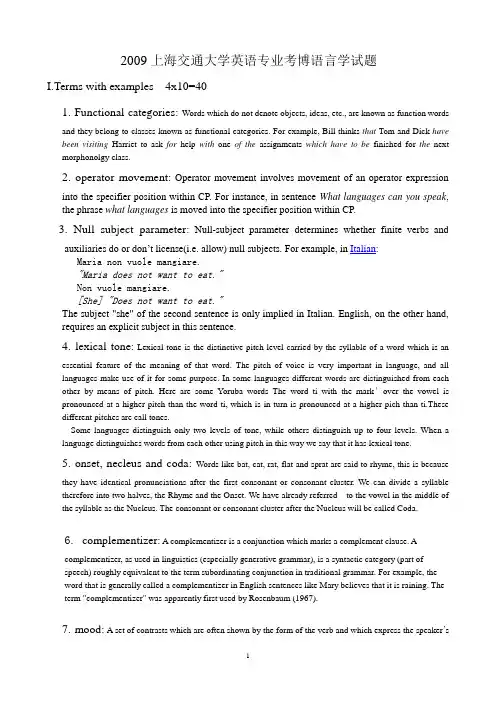
2009上海交通大学英语专业考博语言学试题I.Terms with examples 4x10=401. Functional categories: Words which do not denote objects, ideas, etc., are known as function wordsand they belong to classes known as functional categories. For example, Bill thinks that Tom and Dick have been visiting Harriet to ask for help with one of the assignments which have to be finished for the next morphonolgy class.2. operator movement: Operator movement involves movement of an operator expressioninto the specifier position within CP. For instance, in sentence What languages can you speak, the phrase what languages is moved into the specifier position within CP.3. Null subject parameter:Null-subject parameter determines whether finite verbs andauxiliaries do or don’t license(i.e. allow) null subjects. For example, in Italian: Maria non vuole mangiare."Maria does not want to eat."Non vuole mangiare.[She] "Does not want to eat."The subject "she" of the second sentence is only implied in Italian. English, on the other hand, requires an explicit subject in this sentence.4. lexical tone: Lexical tone is the distinctive pitch level carried by the syllable of a word which is anessential feature of the meaning of that word. The pitch of voice is very important in language, and all languages make use of it for some purpose. In some languages different words are distinguished from each other by means of pitch. Here are some Yoruba words The word ti with the mark′over the vowel is pronounced at a higher pitch than the word ti, which is in turn is pronounced at a higher pich than ti.These different pitches are call tones.Some languages distinguish only two levels of tone, while others distinguish up to four levels. When a language distinguishes words from each other using pitch in this way we say that it has lexical tone.5. onset, necleus and coda: Words like bat, cat, rat, flat and sprat are said to rhyme, this is becausethey have identical pronunciations after the first consonant or consonant cluster. We can divide a syllable therefore into two halves, the Rhyme and the Onset. We have already referred to the vowel in the middle of the syllable as the Nucleus. The consonant or consonant cluster after the Nucleus will be called Coda.6. complementizer: A complementizer is a conjunction which marks a complement clause. Acomplementizer, as used in linguistics (especially generative grammar), is a syntactic category (part ofspeech) roughly equivalent to the term subordinating conjunction in traditional grammar. For example, the word that is generally called a complementizer in English sentences like Mary believes that it is raining. The term "complementizer" was apparently first used by Rosenbaum (1967).7. mood: A set of contrasts which are often shown by the form of the verb and which express the speaker’sor writer’s attitude to what is said or written. Three moods have often been distinguished---indicative mood, imperative mood, subjunctive mood.8. empty category:In syntax, an empty category is a nominal element which does not have anyphonological content and is therefore unpronounced; they may also be referred to as covert nouns, in contrast to overt nouns which are prounounced.9. linguistic determism:one’s thinking is completely determined by his native language because onecannot but perceive the world in terms of the categories and distinctions encoded in that language.The hypothesis my be typically represented by the following statement. “If Aristotle had spoken Chinese, his logic would have been different.”10. conversational maxisms: A conversational maxim is any of four rules which were proposed byGrice 1975, stating that a speaker is assumed to make a contribution thatis adequately but not overly informative (quantity maxim)the speaker does not believe to be false and for which adequate evidence is had (quality maxim)is relevant (maxim of relation or relevance), andis clear, unambiguous, brief, and orderly (maxim of manner)II. Questions 12X5=601.According to some linguists, English is a two-tense, two–aspect language?Comment on the claim.Tense, indicating the time at which the activity took place. English has a binary(i.e. two-way) tense system.Although this distinction is traditionally said to be a past/present tense form, many linguists prefer to see it asa past/none-past distinction, since the so-called present tense form can be used with futuretime-reference(e.g. in sentences such as our guest is arriving at 3 p.m. tomorrow).Aspect is a term used to describe the duration of the activity describled by a verb, e.g. whether the activity is ongoing or completed). The -ing2.By what criteria can we distinguish between central and peripheral外围的ajectives?ExamplesWe have now looked at the main criteria for the adjective class - gradability, comparative and superlative forms, and the ability to occur attributively and predicatively. Most adjectives fulfil all these criteria, and are known as CENTRAL adjectives. Those which do not fulfil all the criteria are known as PERIPHERAL adjectives.In terms of syntactic function, adjective can be divided into two groups: central adjectives and peripheral adjectives.a. central adjectivesMost adjectives can be used both as modifier in a noun phrase and as subject/object complement. These adjectives are called central adjectives. In the following three examples green is a central adjective,functioning as modifier of nouns, subject complement and object complement receptively:Green apples are sour. (modifier in a noun phrase)Those apples are green. (subject complement)They have painted the door green. (object complement)b. peripheral adjectivesPeripheral adjectives refer to the few which can not satisfy both requirements. Someperipheral adjectives can only act as pre-modifier, e.g.chief, main, principal, utter, sheer, etc.other peripheral adjectives can only act as complement, e.g.afloat, afraid, asleep, alone, alive, etc.3.What are the major types of semantic change? What are the possible reasons?Semantic broadening: here the word takes on a wider, more general meaning than it had previously. E.g.The word companion used to mean “someone who eats bread with you”; now it means “someone who is with you”Semmantic narrowing: the word takes on a more restricted meaning than before. In middle english, a girl was a young person of either sex, a boy was a male person of any age and lust simply meant “pleasure”.Pejoration: involves the development of a less favorable meaning or connotation for a particular word. E.g. villains were formerly farm dwellers but are now criminals.Amelioration: the development of more favorable meanings for words, are few in number. Knight which in Old English referred to a boy or servant but now has a more pretigious meaning.Reasons:1.Most words are polysemic-they have a range of meanings- and over time marginal meanings may takeover from central meanings.2.children do not receive a fully formed grammar and lexicon from their parents, but with help fromUniversal grammar, have to figure it out for themselves. The child may therefore acquire a slightly different meaning for a word than that understood by its parents.3.the relationship between concepts and the words which conventionally refer to those concept isarbitrary and so either can vary or change fairly freely through time and across space.4.Saussure, claims that, dialects and languages have no natural boundaries. How doyou understand?(1)The usual conception of dialects nowadays is quite different. They are envisaged as clearly definedlinguistic types, determinate in all respects, and occupying areas on a map which are contiguous and distinct.But natural dialect changes give a quite different result. As soon as linguistics began to study each individual feature and establish its geographical distributions, the old notion of a dialect had to be replaced by a new one, which can be defined as follows: there are no natural dialects, but only natural dialect feature. Or- which comes to the same thing---there are as many dialects as there are places.(2) It is difficult to say what the difference is between a language and a dialect. Often a dialect is called alanguage because it has a literature: that is true of Portuguese and Dutch. The question of intelligibility also plays s part. People who cannot understand one another are generally described as speaking different languages. However, that may be , language which have developed in one continuous area with a settledpopulation exhibit the same phenomena as dialects, but on a larger scale. They show waves of innovation over a territory where a number of different languages are spoken. In the ideal conditions postulated, it is no more feasible to determine boundaries separating related languages than to determine dialect boundaries. The extent of the area involved makes no difference. Just as one cannot say where the High German ends and Low Germans begins, so also it is impossible to establish a line of demarcation between German and Dutch, or between French and Italian.Taking points far enough apart, it is possible to say with certainty “French is spoken here. Italian is spoken there.” But the intervening regions, the distinction becomes blurred. The notion of smaller, compact intermediate zones acting as linguistic areas of transition, for example Proencal as a half-way house between French and Italian , is not realistic either. In any case, it is impossible to imagine in any shape or form a precise linguistic boundary dividing an area covered throughout by evenly differentiated dialects. Language boundaries just like dialect boundaries, get lost in these transitions. Just as dialects are only arbitrary subdivisions of the entire surface covered by a language, so the boundaries held to separate two languages can only be conventional ones.5.The factor of analogy operate in the process of language change.(you can takesound change, verb forms, syntactic construction in English for example .Analogy refers to the use of one form as an exemplar by which other forms can be similarly constructed.1)In middle English, a mouse was called a mus[mu:s], and this mus mayhave lived in someone’s hus [hu:s](house). But now we pronounce musas [maus] and hus is pronounced as [haus] by analogy.2) E.g. based on bow/bows, sow/sows, English speaker began to say cowsinstead of the older kine.3)By analogy to bake/ baked and ignite/ignited, many children and adultsnow say I waked last night( instead of woke) and she lighted the bonfire(instead of lit)。
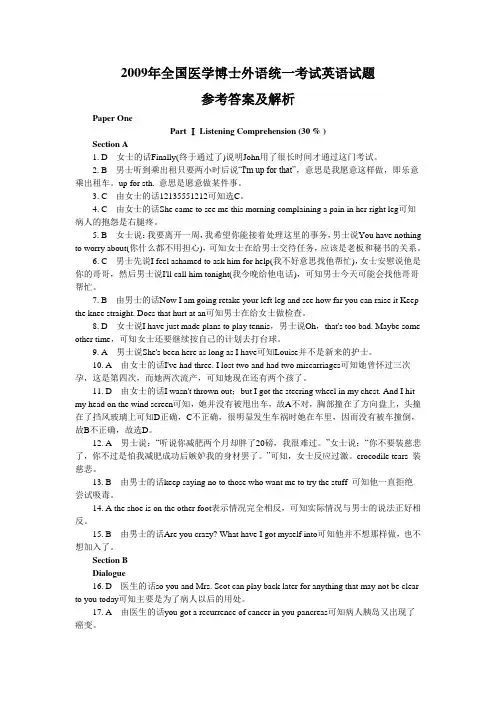
2009年全国医学博士外语统一考试英语试题参考答案及解析Paper OnePart Ⅰ Listening Comprehension (30 % )Section A1. D 女士的话Finally(终于通过了)说明John用了很长时间才通过这门考试。
2. B 男士听到乘出租只要两小时后说“I'm up for that”,意思是我愿意这样做,即乐意乘出租车。
up for sth. 意思是愿意做某件事。
3. C 由女士的话12135551212可知选C。
4. C 由女士的话She came to see me this morning complaining a pain in her right leg可知病人的抱怨是右腿疼。
5. B 女士说:我要离开一周,我希望你能接着处理这里的事务,男士说You have nothing to worry about(你什么都不用担心),可知女士在给男士交待任务,应该是老板和秘书的关系。
6. C 男士先说I feel ashamed to ask him for help(我不好意思找他帮忙),女士安慰说他是你的哥哥,然后男士说I'll call him tonight(我今晚给他电话),可知男士今天可能会找他哥哥帮忙。
7. B 由男士的话Now I am going retake your left leg and see how far you can raise it Keep the knee straight. Does that hurt at an可知男士在给女士做检查。
8. D 女士说I have just made plans to play tennis,男士说Oh,that's too bad. Maybe some other time,可知女士还要继续按自己的计划去打台球。
9. A 男士说She's been here as long as I have可知Louise并不是新来的护士。
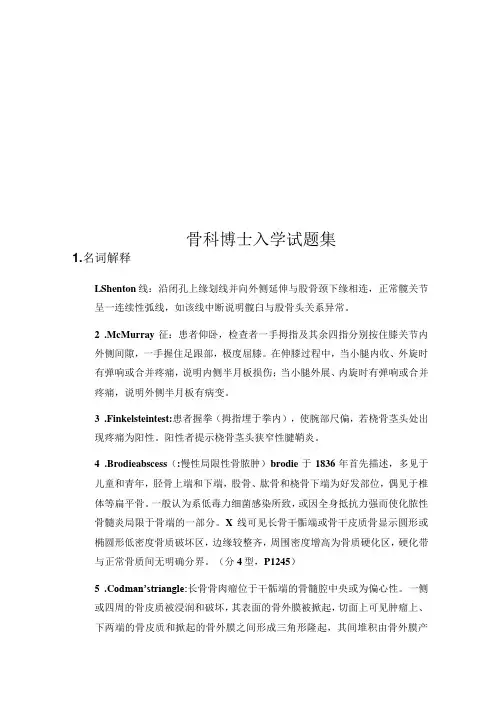
骨科博士入学试题集1.名词解释LShenton线:沿闭孔上缘划线并向外侧延伸与股骨颈下缘相连,正常髋关节呈一连续性弧线,如该线中断说明髋臼与股骨头关系异常。
2.McMurray征:患者仰卧,检查者一手拇指及其余四指分别按住膝关节内外侧间隙,一手握住足跟部,极度屈膝。
在伸膝过程中,当小腿内收、外旋时有弹响或合并疼痛,说明内侧半月板损伤;当小腿外展、内旋时有弹响或合并疼痛,说明外侧半月板有病变。
3.Finkelsteintest:患者握拳(拇指埋于拳内),使腕部尺偏,若桡骨茎头处出现疼痛为阳性。
阳性者提示桡骨茎头狭窄性腱鞘炎。
4.Brodieabscess(:慢性局限性骨脓肿)brodie于1836年首先描述,多见于儿童和青年,胫骨上端和下端,股骨、肱骨和桡骨下端为好发部位,偶见于椎体等扁平骨。
一般认为系低毒力细菌感染所致,或因全身抵抗力强而使化脓性骨髓炎局限于骨端的一部分。
X线可见长骨干骺端或骨干皮质骨显示圆形或椭圆形低密度骨质破坏区,边缘较整齐,周围密度增高为骨质硬化区,硬化带与正常骨质间无明确分界。
(分4型,P1245)5.C odman’striangle:长骨骨肉瘤位于干骺端的骨髓腔中央或为偏心性。
一侧或四周的骨皮质被浸润和破坏,其表面的骨外膜被掀起,切面上可见肿瘤上、下两端的骨皮质和掀起的骨外膜之间形成三角形隆起,其间堆积由骨外膜产生的新生骨。
此三角称为Codman三角。
seque’ssign:患者仰卧,屈髋、膝,于屈髋位伸膝时,引起患肢痛或肌肉痉挛者为阳性。
腰椎间盘突出征的表现之一。
7.Charcot’sjoint:夏科氏关节是指由于某些神经系统疾病引起的关节病变,也被称为神经性关节炎。
常见病因有脊髓痨、脊髓空洞症等。
原发的神经病变可以造成关节深部感觉障碍,对于关节的震荡、磨损、挤压、劳倦不能察觉因而也不能自主地保护和避免,而神经营养障碍又可使修复能力低下,使病人在无感觉状态下造成了关节软骨的磨损和破坏,关节囊和韧带松弛无力,易形成关节脱位和连枷关节。
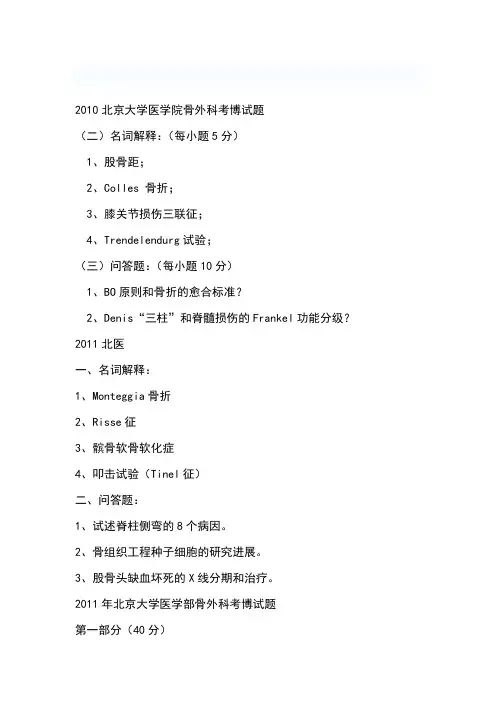
2010北京大学医学院骨外科考博试题(二)名词解释:(每小题5分)1、股骨距;2、Colles 骨折;3、膝关节损伤三联征;4、Trendelendurg试验;(三)问答题:(每小题10分)1、BO原则和骨折的愈合标准?2、Denis“三柱”和脊髓损伤的Frankel功能分级?2011北医一、名词解释:1、Monteggia骨折2、Risse征3、髌骨软骨软化症4、叩击试验(Tinel征)二、问答题:1、试述脊柱侧弯的8个病因。
2、骨组织工程种子细胞的研究进展。
3、股骨头缺血坏死的X线分期和治疗。
2011年北京大学医学部骨外科考博试题第一部分(40分)一、名词解释(5分每题)1、Thomas征2、Pauwel角3、Monteggia fracture4、Cobb角二、问答题(10分每题)1、试述髋关节结核的分型、诊断及治疗原则2、挤压综合征的诊断及治疗第二部分(60分)一、病例分析(5分每题)较简单。
考第一诊断及进一步确诊与治疗。
1、痛风性关节炎急性发作2、慢性化脓性骨髓炎二、简答题1、脊髓损伤的Frankel分级方法(5分)2、骶骨骨折的Dinel分型及临床意义(5分)3、肌肉骨骼肉瘤的Enneking分期(10分)4、肌肉骨骼肉瘤手术边界分类(10分)5、恶性骨肉瘤保肢手术的适用证与禁忌症(10分)6、试述Ewing肉瘤的特异性融合基因及意义。
四、论述7.桡骨远端骨折的诊断,治疗进展,对手术和非手术治疗的理解。
8.股骨转子间骨折的髓内和髓外固定的选择。
9.小腿骨筋膜室间隔区综合症的诊断、治疗第四军医20111.骨折的二期愈合;2.浮膝损伤;3.Jefferson骨折4.Dugas征5.Mipo二、简答:15*31.股骨颈骨折的Garden分型;2.开放性骨折的Gustilo分型;3.颈椎病的分型;三、问答:30*1骨肌系统肿瘤的外科分期2010北京大学医学院骨外科考博试题(二)名词解释:(每小题5分)1、股骨距;2、Colles 骨折;3、膝关节损伤三联征;4、Trendelendurg试验;(三)问答题:(每小题10分)1、BO原则和骨折的愈合标准?2、Denis“三柱”和脊髓损伤的Frankel功能分级?2011北医一、名词解释:1、Monteggia骨折2、Risse征3、髌骨软骨软化症4、叩击试验(Tinel征)二、问答题:1、试述脊柱侧弯的8个病因。
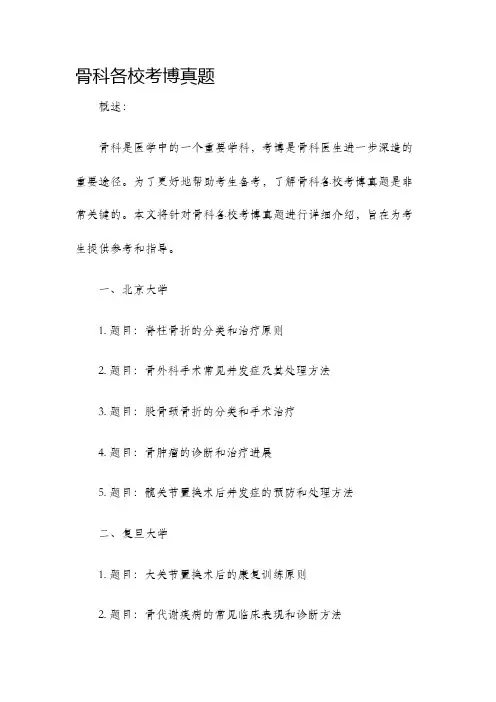
骨科各校考博真题概述:骨科是医学中的一个重要学科,考博是骨科医生进一步深造的重要途径。
为了更好地帮助考生备考,了解骨科各校考博真题是非常关键的。
本文将针对骨科各校考博真题进行详细介绍,旨在为考生提供参考和指导。
一、北京大学1. 题目:脊柱骨折的分类和治疗原则2. 题目:骨外科手术常见并发症及其处理方法3. 题目:股骨颈骨折的分类和手术治疗4. 题目:骨肿瘤的诊断和治疗进展5. 题目:髋关节置换术后并发症的预防和处理方法二、复旦大学1. 题目:大关节置换术后的康复训练原则2. 题目:骨代谢疾病的常见临床表现和诊断方法3. 题目:关节镜在骨科疾病中的应用和发展趋势4. 题目:肩袖断裂的病因和治疗方案5. 题目:骨关节炎的分型和保守治疗方法三、上海交通大学1. 题目:关节镜下前交叉韧带重建术的手术步骤及注意事项2. 题目:骨折愈合的影响因素及改善方法3. 题目:颅骨外伤的危险因素和治疗原则4. 题目:骨质疏松的预防和治疗策略5. 题目:膝关节置换术的适应症和手术技巧四、中山大学1. 题目:创伤性颈椎骨折的急救处理方法2. 题目:髋关节镜检查的操作步骤和要点3. 题目:股骨头坏死的诊断和分期方法4. 题目:脊柱侧弯的病因和治疗原则5. 题目:骨质疏松性骨折的诊断和治疗进展总结:了解骨科各校考博真题对考生备考具有重要意义。
不同学校的考试内容涵盖了骨科的各个方面,包括骨折分类和治疗原则、手术并发症处理、骨肿瘤的诊断和治疗、关节置换术后康复、骨关节炎的治疗等。
考生可以结合真题进行针对性的复习,提高备考效果。
在备考过程中,建议考生多做题、多练习,熟悉各个学校的考题风格,加强知识点的掌握,提高解题能力。
同时,考生也应该关注骨科领域的最新进展,了解最新的研究成果和临床应用,为考试做好充分准备。
最后,祝愿所有考生取得优异成绩,顺利进入理想的骨科医学研究领域!。
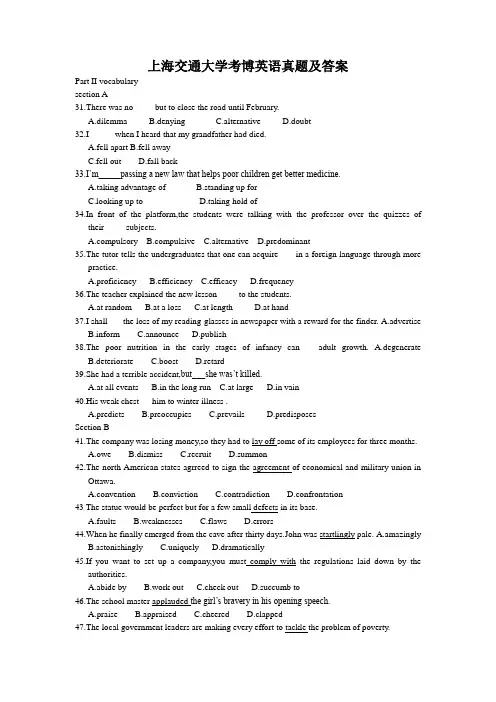
上海交通大学考博英语真题及答案Part II vocabularysection A31.There was no_____but to close the road until February.A.dilemmaB.denyingC.alternativeD.doubt32.I______when I heard that my grandfather had died.A.fell apartB.fell awayC.fell outD.fall back33.I’m_____passing a new law that helps poor children get better medicine.A.taking advantage ofB.standing up forC.looking up toD.taking hold of34.In front of the platform,the students were talking with the professor over the quizzes oftheir_____subjects.pulsorypulsiveC.alternativeD.predominant35.The tutor tells the undergraduates that one can acquire____in a foreign language through morepractice.A.proficiencyB.efficiencyC.efficacyD.frequency36.The teacher explained the new lesson_____to the students.A.at randomB.at a lossC.at lengthD.at hand37.I shall ___the loss of my reading-glasses in newspaper with a reward for the finder. A.advertisermC.announceD.publish38.The poor nutrition in the early stages of infancy can ___adult growth. A.degenerateB.deteriorateC.boostD.retard39.She had a terrible accident,but___she was’t killed.A.at all eventsB.in the long runC.at largeD.in vain40.His weak chest___him to winter illness .A.predictsB.preoccupiesC.prevailsD.predisposesSection B41.The company was losing money,so they had to lay off some of its employees for three months.A.oweB.dismissC.recruitD.summon42.The north American states agrreed to sign the agreement of economical and military union inOttawa.A.conventionB.convictionC.contradictionD.confrontation43 The statue would be perfect but for a few small defects in its base.A.faultsB.weaknessesC.flawsD.errors44.When he finally emerged from the cave after thirty days.John was startlingly pale. A.amazinglyB.astonishinglyC.uniquelyD.dramatically45.If you want to set up a company,you must comply with the regulations laid down by theauthorities.A.abide byB.work outC.check outD.succumb to46.The school master applauded the girl’s bravery in his opening speech.A.praiseB.appraisedC.cheeredD.clapped47.The local government leaders are making every effort to tackle the problem of poverty.A.abolishB.addressC.extinguishD.encounter48.This report would be intelligible only to an expert in computing.A.intelligentprehensivepetentprehensible49.Reading a book and listening to music simultaneously seems to be mo problem for them.A.intermittentlyB.constantlyC.concurrentlyD.continuously50.He was given a laptop computer in acknowledgement of his work for the company.A.accomplishmentB.recognitionC.apprehensionmitmentPart III CloseIn Mr.Allen’s high school class,all students have to “get married”.However,the wedding ceremonies are not real ones but 51 .These mock ceremonies sometimes become so 52 that the loud laughter drowns out the voive of the “minister”.Even the two students getting married often begin to giggle.The teacher Mr. Allen,believes that marriage is a difficult and serious business.He wants young people to understand that there are many changes that 53 take place after marriage.He believes that the need for these psychological and financial 54 should be understood before people marry.Mr.Allen does’t only introduce his students to major problems 55 in marriage such as illness or unemployment.He also expose them to nitty-gritty problems they will face every day.He wants to introduce young people to all the trials and 56 that can strain a marriage to the breaking point .He even 57 his students with the problems of divorced men must pay child support money for their wives.It has been upsetting for some of the students to see the problems that a married couple often faces. 58 they took the course,they had not worried much about the problems of marriage.However,both students and parents feel that Mr.Allen’s course is valuable and have 59 the course publicly.There statements and letters supporting the class have, 60 the school to offer the course again,51. A.duplications B.imitations C.assumption D.fantasies52. A.noisy B.artificial C.graceful D.real53. A.might B.would C.must D.need54. A.issues B.adjustments C.matters D.expectancies55. A.to face B.facing C.having faced D.faced56. A.tribulations B.errors C.triumphs D.verdicts57. rms B.concerns C. triumphs D.associates58. A.Until B.Before C.After D.As.59. A.taken B.suggested C.endorsed D.reproched60. A.confined B.convinced promised D.conceivedpassage oneWhy do people always want to get up and dance when they hear music? The usual explanation is that there is something embeded in every culture-----that dancing is a “cul tural universal”. A researcher in Manchester thingks the impulse may be more deeply rooted than that.He says it may be a reflex reaction.Neil Todd,a psychologist at the University of Manchester. told the BA that he first got an inkling that biology was the key after watching people dance to deafeningly loud music.“There is a compulsion about it.”he says.He reckoned there might be a more direct,biological,explanation for the disre to dance,so he started to look at the inner ear.The human ear has two main functions:hearing and maintaining balance.The standard view is that these tasks are segregated so that organs for balance,for insance,do not have an acoustic function.But Todd says animal studies have shown that the sacculus,which is part of the balance---regulating vestibular system,has retain some sensitivity to sound.The sacculus is especially sensitive to extremely loud noise,above 70 decibel.“There’s no question that in a contemporary dance environment,the sacculus will be stimulated.”says Todd.The av erage rave,he says,blares music at a painful 110 to 140 decibels.But no one really knows what an acoustically stimulated sacculus does.Todd speculates that listening to ex tremely loud music is a form of “vestibular self-stimulation”:it gives a he ightened sensation of motion. “We don’t know exactly why it causes pleasure.”he says.”But we know that people go to extraordinary length to get it.”He list bungee jumping,playing on swings or even rocking to and fro in a rocking chair as other example of pursuits designed to stimulate the sacculus.The same pulsing that makes us feel as though we are moving may make us get up and dances as well,says Todd.Loud music sends signals to the inner ear which may prompt reflex movement. “The typical pulse rate of dance musi c is around the rate of locomo tion.”he says,“It’s quite possible you’re triggering a spinal reflex.”61.The passage begins with______A. a new explanation of musicB. a cultural universal questionedC. a common psychological abnormalityD. a deep insight into human physical movenents62.What intrigued Todd was ______A.human instinct reflexesB.people’s biological heritagesC.people’s compulsion about loud musicD.the damages loud music wrecks on human hearing63.Todd’s biological e xplanation for the desire to dance refers to_____A.the mechanism of hearing soundsB.the response evoked from the sacculusC.the two main functions performed by the human earD.the segregation of the hearing and balance maintaining function64.When the sacculus is acoustically stimulated,according to Todd_____A.functional balance will be maintained in the earB.pleasure will be arousedC.decibel will shoot upD.hearing will occur65.What is the passage mainly about?A.The human ear does more than hearing than expcted.B.Dancing is capable of heighten the sensation of hearingC.Loud music stimulates the inner ear and generates the urge to danceD.The human inner ear does more to help hear than to help maintain balance.passage 2Have you switch off your compter? How about your television? Your video? Your CD player? And even your coffee percolator? Really switched them off,not just pressed the button on some conrtol panel and left your machine with a telltale bright red light warning you that it is ready to jump back to life at your command?Because if you haven’t,you are one of the guilty people who help pollute the planet.It does’t matter if you’ve joined the neighborhood recycling scheme,conscientiously sorted your garbage and avoided driving to work.You still can’t sleep easy while just one of those little red lights is glowing in the dark.The awful truth is that household and office electrical appliances left on stand-by mode are gobbling up energy,even though they are doing absolutely nothing.Some electronic products-----such as CD players----can use almost as much energy on stand-by as they do when running.Others may use a lot less,but as your video player spend far more hours on stand-by than playing anything,the wastage soon adds up.In the US.alone,idle electronic devices consume enough energy to power cities with the energy needs of Chicago or London----costing consumers around $1 billion a year.Power stations fill the atmosphere with carbon dioxide just to do absolutely nothing.Thoughtless design is partly responseble for the waste.But manufactures only get away with desinging products that waste energy this way because consumers are not sensitive enough to the issue,indeed,while recycling has caught the public imagination ,reducing waste has attracted much less attention.But “source reduction”,as the garbage experts like to call the art of not using what you don’t need to use,offers enormous potential for reducing waste of all kinds.With a little intelligent shopping,you can cut waste long before you reach the end of the chain.Packaging remains the big villain.One of the hidden consequences of buying products grown or made all around the world,rather than produced locally,is the huge amount of packaging.To help cut the waste and encourage intelligent manufacturers the simplest trick is to look for ultra-light package.The same arguments apply to the very light but strong plastic bottles that are replacing heavier glass alternatives,thin-walled aluminum cans,and cartons made of composites that wrap up anything drinkable in an ultra-light package.There are hundreds of other tricks you can discuss with colleagues while gathering around the proverbial water cooler—filling up,naturally,your own mug rather than a disposable plastic cup.But you don’t need to go as far as one website which tells you how to give your friends unwrapped Christmas presents.There are limits to source correctness.66. Fron the first two paragraphs,the author implies that______A.hitch has made life easy everywhereB.nobody seems to be innocent in polluting the planetC.recycling can potentially control environmental deteriorationD.everybody is joining the global battle against pollution in one way or another67.The waste caused by household and office electrical appliances on stand-by mode seemsto_____A.be a long-standing indoor problemB.cause nothing but troubleC.get exaggeratedD.go unnoticed68.By idle electronic devices,the author means those appliances_____A.left on stand-by modeB.filling the atmosphere with carbon dioxideed by those who are mot energy-conscioused by those whose words spesk louder than actions69.Ultra-light packaging______A.is expected to reduce American waste bu one-thirdB.is an illustration of what is called “source reduction”C.can make both manufacturers and consumers intelligentD.is a villain of what the garnage experts call “source reduction”70.The conclusion the author is trying to draw is that______A.one person cannot win the battle against pollutionB.anybody can pick up tricks of environmental protection on the webC.noybody can be absolutely right in all the tricks of environmental protectionD.anybody can present or learn a trick of cutting down what is not neededpassage 3You can have too much of a good thing,it seems---at least when it comes to physiotherapy after a stroke. Many doctors believe that it is the key to recovery:exetcising a partially paralyzed limb can help the brain “rewire”itself and replace neural co nnections destroyed by a clot in the brain.But the latest animal experiments suggest that too much exercise too soon after a brain injury can make the damage worse. “It’s something that clinicians are not aware of,”says Timothy Schallert of the University at Austin,who led the research.In some trials,stroke victims asked to put their good arm in a sling---to force them to use their partially paralyzed limb---had made much better recoveries than those who used their good arm. But these patients were treated many months after their strokes.Earlier intervention,Schallert reasoned,should lead to even more dramatic improvements.To test this theory,Schallert and his colleagues placed tiny casts on the good forelimbs of rats for two weeks immediately after they were given a small brain injury that partially paralyzed one forelimb.Several weeks later, the researchers were astonished to find that brain tissue surruouding the original injury had also died. “The size of the injury doubled. It’s very dramatic effect.”says Schallert.Brain-injured rats that were not forced to overuse their partially paralyzed limbs showed no similar damage,and the casts did not cause a dramatic loss of brain tissue in animals that had not already suffered minor brain damage.In subsequent experiments,the researchers have found that the critical period for exercise-induced damage in rats is the first week after the initial brain injury.The spreading brain damage witnessed by Schaller’s team was probably caused by the releaseof glutamate,a neurotransmitter,from brain cells stimulated during limb movement.At high doses,glutamate is toxic even to healthy nerve cells.And Schallert believes that a brain injury makes neighboring cells unusually susceptible to the neurotransmitter’s toxic effects.Randolph Nudo of the University of Texas Health Science Center at Houston,who studies brain injury in primates,agrees that glutamate is the most likely culprit.In experiments with squirrel monkeys suffering from stroke-like damage,Nudo tried beginning rehabilitation within five days of injury.Although the treatment was bebeficial in the long run,Nudo noticed an initial worsening of the paralysis that might also have been due to brain damage brought on by exercise.Schallert stresses that mild exercise is likely to be beneficial however soon it begins.He adds that it is unclear whether human victims of strokes,like brain -injured rats,could make their problems worse by exercising too vigorously,too soon.Some clinics do encourage patients to begin physiotherapy within a few weeks of suffering a traumatic head injury or stroke,says David Hovda,director of brain injury research at the University of California,Los Angeles.But even if humans do have a similar period of vulnerability to rat,he speculates that it might be possible to use drugs to block the effects of glutamate.71. Schallert issued a warning to those who____A.believe in the possibility of rewiring the brainB.are ignorant of physiotherapy in the clinicC.add exercise to partially paralyzed limbsD.are on the verge of a stroke72.Which of the following is Schallert’s hypothesis for his investigation.?A.Earlier intervention should lead to even more dramatic improvements.B.The critical period for braim damage is one week after injury.C.A partially paralyzed limb can cause brain damagesD.Physiotherapy is the key to brain recovery.73.The results from Schallert’s rese arch____A.reinforced the singificance of physiotherapy after a strokeB.indicated the fault with his experiment designC.turned out the oppsiteD.verified his hypothesis74.The results made Schallert’s team aware of the fact that____A.glutamate can have toxic efforts on healthy nerve cellsB.exercise can boost the release of glutamateC.glutamate is a neurotransmitterD. all of the above75.Schallert would probably advise clinicians____A.to administer drugs to blick the effects of glutamateB.to be watchful of the amount of exercise for stroke victimsC.to prescribe vigorous exercise to stroke vivtims one week after injuryD.to reconsider the significance of phusiotherapy to brain damagePssage FourOur understanding of cities in anything more than casual terms usually starts with observationsof their spatial form and structure at some point or cross-section in time.This is easiest way to begin,for it is hard to assemble data on how cities change through time,and, in any case,our perceptions often betray us into thinking of spatial structures as being resilient and long lasting.Even where physical change is very rapid,this only has an impact on us when we visit such places infrequent -ly ,after years away. Most of our urban theory,whether it emanates from the social sciences or engineering,is structured around the notion that spatial and spatial and social structures change slowly,and are sufficiently inert for us to infer reasonable explanations from cross-sectional studies.In recent years,these assumptions have come to be challenged,and in previous editorials I have argued the need for a more temporal emphasis to our theories and models,where the emphasis is no longer on equilibrium but on the intrinsic dynamics of urban change.Even these views,however,imply a conventional wisdom where the real focus of urban studies is on processes that lead to comparatively slow changes in urban organization,where the functions determining such change are very largely routine,accomplished over months or years,rather than any lesser cycle of time.There is a tacit assumption that longer term change subsumes routine change on a day-to-day or hour-basis,which is seen as simply supporting the fixed spatial infrastructures that we perceive cities to be built around .Transportation modeling,for example,is fashioned from thes standpoint in that routine trip-making behavior is the focus of study,its explanation being central to the notion that apatial structures are inert and long lasting.76.We ,according to the passage,tend to observe citiesA.chronologicallyB.longitudinallyC.sporadicallyD.horizontally77.we think about a city as____A.a spatial eventB.a symbolica worldC.a social environmentD.an intertelated system78.Cross-sectional studies show that cities ____A.are structured in three dimensiosB.are transformed rapidly in any aspectC.are resilient and long lasting rhrougy timeD.change slowly in spatial and social structrues79.The author is drawing our attention to ____A.the equilibrium of urban spatial structuresB.the intrinsic dynamics of urban changeC.the fixed spatial infrastructureD.all of the above80.The conventional notion,the aurhor contends,____A.presents the inherent nature of a cityB.underlies the fixed spatial infrastructuresC.places an emphasis on lesser cycles of timeD.hinders the physical change of urban structurePassane fiveWhen it is sunny in June,my father gets in his first cutting of hay.He starts on the creek meadows,which are flat,sandy,and hot.They are his driest land.This year,vacationing from my medical practice,I returned to Vermont to help with the haying.The heft of a bale through my leather gloves is familiar:the tautness of the twine,the heave ofthe bale,the sweat rivers that run through the hay chaff on my arms.This work has the smell of sweet grass and breeze.I walk behind the chug and clack of the baler,moving the bales into piles so my brother can do the real work of picking them up later.As hot as the air is,my face is hotter.I am surprised at how soon I get tired.I take a break and sit in the shade,watching my father bale,trying not to think about how old he is,how the heat affects his heart,what might happen.This is not my usual work,of course.My usual work is to sit with patients and listen to them.Occasionslly I touch them,and am glad that my hands are soft.I don’t think my patients would like farmer callouses and dirty hands on their tender spots.Reluctantly I feel for lumps in breasts and testicles,hidden swellings of organs and joints,and probe all the painful places in my patients’lives.There are many,Perhaps I am too soft,could stand callouses of a different sort.I feel heavy after a day’s work ,as if my pat ients were inside me,letting me carry them.I don’t mean to.But where do I put their stories? The childhood beatings,ulcers from stress, incapacitating depression,fears,illness? These are not my experiences,yet I feel them and carry them with me.Try to find healthier meanings,I spent the week before vacation crying.The hay field is getting organized.Piles of three and four bales are scattered around the field.They will be easy to pick up.Dad climbs,tired and lame,from the tractor.I hand him a jar of ice w ater,and he looks with satisfaction on his job just done.I’ll stack a few more bales snd maybe drive the truck for my brother.My father will have some appreciative customers this winter,as he sells his bales of hay.I’ve needed to feel this heaviness in my muscles,the heat on my face.I am taunted by the simplicity of this work,the purpose and results,the definite boundaries of the fields,the dimensions of the bales,for illness is not defined by the boundaries of bodies;it spills into families ,homes, schools,and my office,like hay tumbling over the edge of the cutter bar.I feel the rough stubble left in its wake.I need to remember the stories I’ve helped reshape,new meanings stacked against the despair of pain,I need to remember the smell of hay in June.81.Which of the following is NOT true according to the story?A.The muscular work in the field has an emotional impact on the narrator.B.The narrator gets tired easily working in the field.C.It is the first time for the narroator to do hayingD.The narrator is as physician82.In retrospection ,the narrator___A.feels guilty before his father and brotherB.defends his soft hands in a meaningful wayC.hates losing his muscular power before he knows itD.is shamed for the farmer callouses he does not possess83.As a physician,the narrator is ___A.empathicB.arrogantC.callousD.fragile84.His associations punctuate_____A.the similarities between medicine and agricultureB.the simplicity of muscular workC.the hardship of life everywhereD.the nature of medical practice85.The narrator would say that____A.it can do physicians good to spend a vacation doing muscular workB.everything is interlinked and anything can be anythingC.he is a shame to his fatherD.his trip is worth itPassage SixEveryone has seen it happen,A colleague who has been excited,involved,and productive slowly begins to pull back,lose energy and interest,and becomes a shadow or his or her former self.Or,a person who has been a beacon of vision and idealism retreats into despair or cynicism.What happened? How does someone who is capable and committed become a person who functions minimally and does not seem to care for the job or the people that work there?Burnout is a chronic state of depleted energy ,lack of commitment and involvement,and continual frustration,often accompanied at work by physical symptoms,disability claims and performance problem.Job burnout is a crisis of spirit,when work that was once exciting and meaningful becomes deadening. An organization’s mo st valuable resource---the energy ,dedication,and creativity of its employees---is often squandered by a climate that limits or frustrates the pool of talent and energy available.Milder forms of burnout are a problem at every level in every type of work.The burned-out manager comes to work,but he brings a shell rather than a person.He experiences little satisfaction,and feels uninvolved,detached,and uncommitted to his work and co-workers.While he may be effective by external standards,he works far below his own level of productivity. The people around him are deeply affected by his attitude and energy level,and the whole community begins to suffer.Burnout is a crisis of the spirit because people who burn out were once on fire.It’s especially scary …………….some of the most talented .If they can’t maintain their fire,others ask who can? Are these people lost forever,or can the inner flame be rekindled? People often feel that burnout just comes upon them and that they are helpless victims of it. Actually,the evidence is growing that there were ways for individuals to safeguard and renew their spirit,snd more important,there are ways for organizations to change conditions that lead to burnout.86.The passage begins with____A.a personal transitionB.a contrast between two types of peopleC.a shift from conformity to individualityD.a mysterious physical and mental state87.Which of the following is related with the crisis of spirit?A.Emotional exhaustionB.DepersonalizationC.Reduced personal accomplishmentD.All of the above88.Job burnout is a crisis of spirit,which will result in ___A.a personal problemB.diminished productivityC.an economic crisis in a countryD.a failure to establish a pool of talent and energy89.Burnout can be ___A.fatalB.staticC.infectiousD.permanent90.Those who are burned-out,according to the passage,are potentially able___A.to find a quick fixB.to restore what they have lostC.to be aware of their status quoD.to challenge their organization A.B.C.D. A.B.C.D. A.B.C.D.。
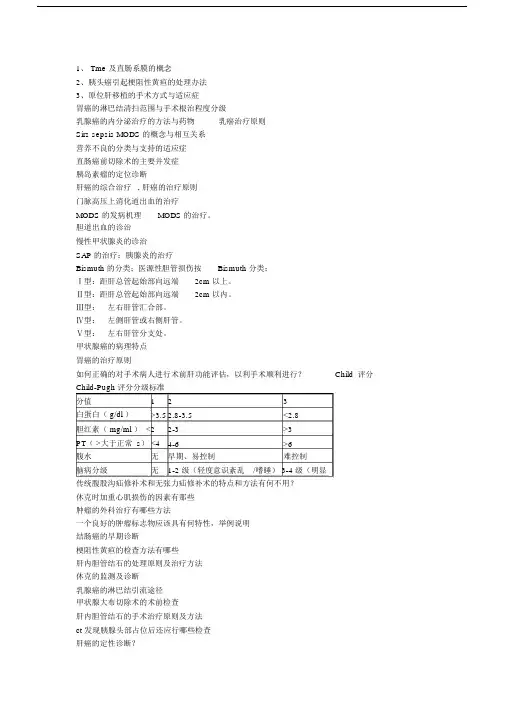
1、 Tme 及直肠系膜的概念2、胰头癌引起梗阻性黄疸的处理办法3、原位肝移植的手术方式与适应症胃癌的淋巴结清扫范围与手术根治程度分级乳腺癌的内分泌治疗的方法与药物乳癌治疗原则Sirs sepsis MODS 的概念与相互关系营养不良的分类与支持的适应症直肠癌前切除术的主要并发症胰岛素瘤的定位诊断肝癌的综合治疗, 肝癌的治疗原则门脉高压上消化道出血的治疗MODS 的发病机理MODS 的治疗。
胆道出血的诊治慢性甲状腺炎的诊治SAP 的治疗:胰腺炎的治疗Bismuth 的分类;医源性胆管损伤按Bismuth 分类:Ⅰ型:距肝总管起始部向远端2cm 以上。
Ⅱ型:距肝总管起始部向远端2cm 以内。
Ⅲ型:左右肝管汇合部。
Ⅳ型:左侧肝管或右侧肝管。
Ⅴ型:左右肝管分支处。
甲状腺癌的病理特点胃癌的治疗原则如何正确的对手术病人进行术前肝功能评估,以利手术顺利进行?Child 评分Child-Pugh 评分分级标准分值 1 2 3白蛋白( g/dl )>3.5 2.8-3.5 <2.8胆红素( mg/ml ) <2 2-3 >3PT( >大于正常 s) <4 4-6 >6腹水无早期、易控制难控制脑病分级无1-2 级(轻度意识紊乱/嗜睡) 3-4 级(明显传统腹股沟疝修补术和无张力疝修补术的特点和方法有何不用?休克时加重心肌损伤的因素有那些肿瘤的外科治疗有哪些方法一个良好的肿瘤标志物应该具有何特性,举例说明结肠癌的早期诊断梗阻性黄疸的检查方法有哪些肝内胆管结石的处理原则及治疗方法休克的监测及诊断乳腺癌的淋巴结引流途径甲状腺大布切除术的术前检查肝内胆管结石的手术治疗原则及方法ct 发现胰腺头部占位后还应行哪些检查肝癌的定性诊断?孕期阑尾炎的诊断治疗原则胃癌的手术发式肝移植的适应症和手术方式甲状腺结节的处理原则闭合性腹部损伤非手术治疗期间应观察哪些指标普外:二问答1PMC (甲状腺乳头状微小腺癌)及其目前治疗原则2 Budd-Chiari syndrome 的分型及手术治疗方法布加综合征由各种原因所致肝静脉和其开口以上段下腔静脉阻塞性病变引起的常伴有下腔静脉高压为特点的一种肝后门脉高压症。
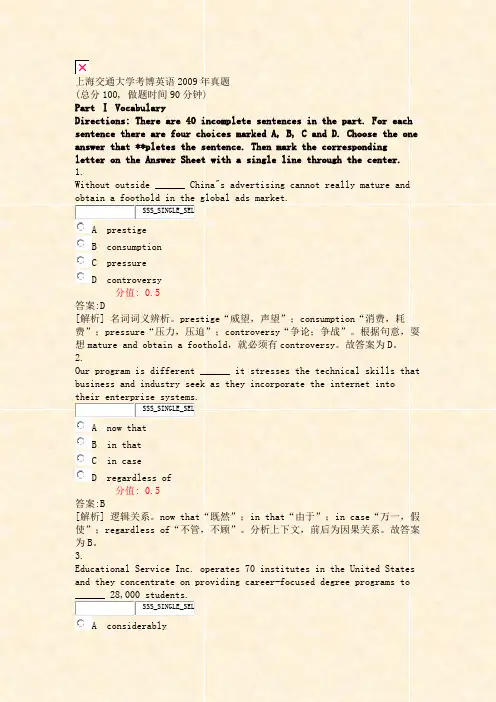
上海交通大学考博英语2009年真题(总分100, 做题时间90分钟)Part Ⅰ VocabularyDirections: There are 40 incomplete sentences in the part. For each sentence there are four choices marked A, B, C and D. Choose the one answer that **pletes the sentence. Then mark the correspondingletter on the Answer Sheet with a single line through the center. 1.Without outside ______ China"s advertising cannot really mature and obtain a foothold in the global ads market.SSS_SINGLE_SELA prestigeB consumptionC pressureD controversy分值: 0.5答案:D[解析] 名词词义辨析。
prestige“威望,声望”;consumption“消费,耗费”;pressure“压力,压迫”;controversy“争论;争战”。
根据句意,耍想mature and obtain a foothold,就必须有controversy。
故答案为D。
2.Our program is different ______ it stresses the technical skills that business and industry seek as they incorporate the internet intotheir enterprise systems.SSS_SINGLE_SELA now thatB in thatC in caseD regardless of分值: 0.5答案:B[解析] 逻辑关系。
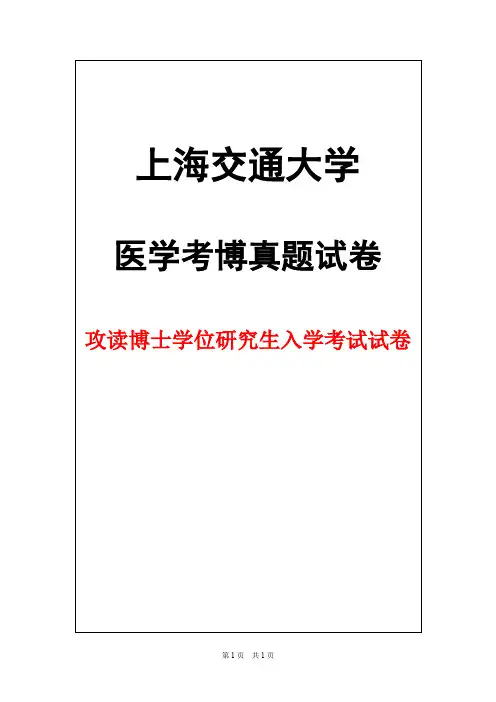
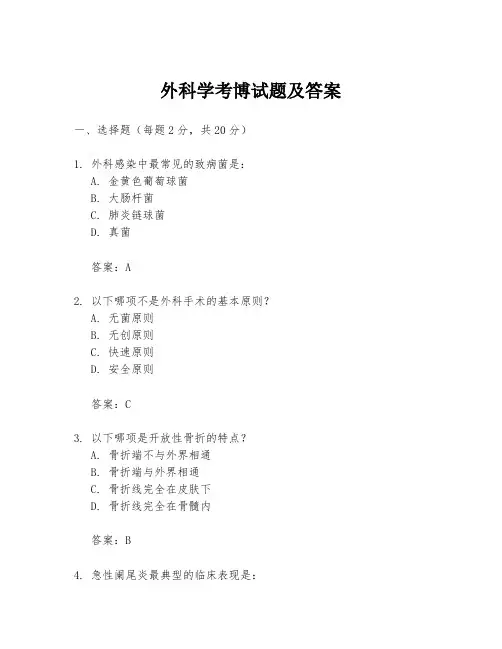
外科学考博试题及答案一、选择题(每题2分,共20分)1. 外科感染中最常见的致病菌是:A. 金黄色葡萄球菌B. 大肠杆菌C. 肺炎链球菌D. 真菌答案:A2. 以下哪项不是外科手术的基本原则?A. 无菌原则B. 无创原则C. 快速原则D. 安全原则答案:C3. 以下哪项是开放性骨折的特点?A. 骨折端不与外界相通B. 骨折端与外界相通C. 骨折线完全在皮肤下D. 骨折线完全在骨髓内答案:B4. 急性阑尾炎最典型的临床表现是:A. 腹痛B. 恶心呕吐C. 右下腹固定压痛D. 发热答案:C5. 以下哪项是乳腺癌的高危因素?A. 长期吸烟B. 长期饮酒C. 家族遗传史D. 长期素食答案:C二、简答题(每题10分,共30分)1. 简述外科手术切口的分类及其特点。
答案:外科手术切口根据其感染风险分为三类:清洁切口、可能污染切口和污染切口。
清洁切口是指手术区域无炎症,无感染,且手术过程中未进入呼吸道、消化道、泌尿生殖道及口咽部。
可能污染切口是指手术区域可能存在细菌,但无明显感染,如胃肠道手术。
污染切口是指手术区域有明显感染或手术过程中进入有菌环境,如脓肿切开引流。
2. 描述急性胆囊炎的诊断要点。
答案:急性胆囊炎的诊断要点包括:右上腹疼痛,尤其是Murphy征阳性;发热和白细胞计数升高;腹部超声检查发现胆囊壁增厚、胆囊内结石或胆囊周围积液;有时可伴有黄疸。
3. 解释何为“无菌技术”及其在外科手术中的重要性。
答案:无菌技术是指在手术过程中采取的一系列措施,以防止手术区域受到微生物污染。
这包括使用无菌器械、穿戴无菌手术衣和手套、保持手术区域清洁等。
无菌技术在外科手术中至关重要,因为它可以显著降低术后感染的风险,提高手术成功率。
三、论述题(每题25分,共50分)1. 论述外科手术前的准备要点。
答案:外科手术前的准备要点包括:详细的病史采集和体格检查,以评估患者的整体健康状况和手术风险;必要的辅助检查,如血常规、凝血功能、心电图、肝肾功能等;术前禁食和禁水,以减少术中呕吐和误吸的风险;术前抗生素的使用,以预防感染;心理支持和教育,以减轻患者的焦虑和恐惧。
2009年医学博士外语真题试卷(题后含答案及解析)题型有:1. 2. 3. 4. 5. PartⅢCloze 6. PartⅣReading Comprehension 7. PartⅤWritingSection A听力原文:M: Did you hear that John has passed the Step One United States Medical Licensing Examination? W: Finally.Q: What does the woman imply?1.A.John failed the exam.B.John didn’t take the exam.C.John passed the exam, but scored low.D.It took John a long time to pass the exam.正确答案:D解析:女士的话Finally(终于通过了)说明John用了很长时间才通过这门考试。
听力原文:M: It’ s a one day trip. It must be pretty close. W: It’ s about four hours by train.M: Ha, OK. How else we can get there?W: Well, I think, by taxi, it’s only about two hours.M: I’ m up for that.Q: What does the man prefer to do?2.A.To travel by train.B.To go by Taxi.C.To go hiking.D.To rent a car.正确答案:B解析:男士听到乘出租只要两小时后说“I’m up for that”,意思是我愿意这样做,即乐意乘出租车。
up for sth.意思是愿意做某件事。
博士考试外科学试题及答案一、选择题(每题2分,共20分)1. 以下哪项不是外科手术的基本原则?A. 无菌原则B. 无创原则C. 快速原则D. 个体化原则2. 外科手术中,最常见的感染类型是:A. 细菌性感染B. 真菌性感染C. 病毒性感染D. 寄生虫感染3. 以下哪个不是外科手术的常见并发症?A. 出血B. 感染C. 疼痛D. 过敏4. 外科手术中,以下哪个操作不属于基本操作?A. 切开B. 缝合C. 切除D. 放射治疗5. 以下哪个是外科手术中常用的止血方法?A. 电凝B. 冷冻C. 药物D. 按摩6. 外科手术中,以下哪个不是常用的麻醉方式?A. 局部麻醉B. 椎管内麻醉C. 全身麻醉D. 表面麻醉7. 以下哪个不是外科手术的术后护理措施?A. 观察生命体征B. 伤口护理C. 预防感染D. 立即进食8. 外科手术中,以下哪种情况需要紧急处理?A. 轻微出血B. 术中发现肿瘤C. 术中出现心跳骤停D. 术后轻度疼痛9. 以下哪个不是外科手术的术前准备?A. 血常规检查B. 心电图检查C. 禁食禁水D. 术后饮食计划10. 外科手术中,以下哪个不是手术器械?A. 手术刀B. 镊子C. 止血钳D. 听诊器答案:1. C2. A3. D4. D5. A6. D7. D8. C9. D 10. D二、简答题(每题10分,共30分)1. 请简述外科手术的无菌操作原则。
2. 描述一下外科手术中常见的止血方法。
3. 术后护理中,如何预防感染?三、论述题(每题25分,共50分)1. 论述外科手术中的风险评估和风险管理的重要性。
2. 论述外科手术的术前准备和术后护理的重要性。
结束语:外科手术是医学领域中非常重要的一部分,它不仅要求医生具备高超的技艺,还需要对手术的每一个环节都有深入的了解和严格的控制。
通过本试题,我们希望考生能够对外科手术的基本原则、操作技巧、风险管理以及术前术后的护理有更全面的认识,从而在未来的医学实践中能够更好地服务于患者。
2009年上海交大考博部分考试科目参考书目部分考试科目参考书目010船舶海洋与建筑工程学院2201流体力学《水动力学基础》,刘岳元等,上海交大出版社2202声学理论《声学基础理论》,何祚庸,国防工业出版社2203高等工程力学(理力、材力、流力、数学物理方法)(四部分任选二部分做)《理论力学》,刘延柱等,高等教育出版社;《材料力学》,单祖辉,北京航空航天大学出版社;《流体力学》,吴望一,北京大学出版社;《数学物理方法》,梁昆淼,高等教育出版社2204结构力学《结构力学教程》,龙驭球,高等教育出版社3301船舶原理《船舶静力学》,盛振邦,上海交大出版社;《船舶推进》,王国强等,上海交大出版社;《船舶耐波性》,陶尧森,上海交大出版社;《船舶阻力》,邵世明,上海交大出版社3302振动理论(I)《机械振动与噪声学》,赵玫等,科技出版社20043303海洋、河口、海岸动力学《河口海岸动力学》,赵公声等,人民交通出版社20003304高等流体力学《流体力学》,吴望一,北京大学出版社3305弹性力学《弹性力学》上、下册(第二版),徐芝纶,高等教育出版社3306振动理论(Ⅱ)《振动理论》,刘延柱等,高等教育出版社20023307钢筋混凝土结构《高等钢筋混凝土结构学》,赵国藩编,中国电力出版社3308地基基础《土工原理与计算》(第二版),钱家欢、殷宗泽,水利电力出版社3378船舶结构力学《船舶结构力学》,陈铁云、陈伯真,上海交大出版社020机械与动力工程学院2205计算方法《计算方法》,李信真,西北工业大学出版社2206核反应堆工程《核反应堆工程设计》,邬国伟3309工程热力学《工程热力学》(第三版),沈维道;《工程热力学学习辅导及习题解答》,童钧耕3310传热学《传热学》(第三版),杨世铭3311机械控制工程《现代控制理论》,刘豹;《现代控制理论》,于长官3312机械振动《机械振动》,季文美3313生产计划与控制《生产计划与控制》,潘尔顺,上海交通大学出版社3314机械制造技术基础《机械制造技术基础》,翁世修等,上海交通大学出版社1999;《现代制造技术导论》,蔡建国等,上海交通大学出版社20003315现代机械设计《高等机械原理》,高等教育出版社1990030电子信息与电气工程学院2207信号与系统《信号与系统》,胡光锐,上海交大出版社2208电子科学与技术概论《电子科学与技术导论》,李哲英,20062209信息处理与控制系统设计《线性系统理论》,郑大钟,清华大学出版社2002;或《数字图像处理》(第二版)《Digital Image Processing》Second Edition (英文版),R. C. Gonzalez, R. E. Woods,电子工业出版社2002(从“线性系统理论”或“图像处理”中选考其一)2210计算机科学与技术方法论《数理逻辑与集合论》,石纯一,清华大学出版社2000;《图论与代数结构》,戴一奇,清华大学出版社1995;《组合数学》,Richard A. Brualdi著,卢开澄等译,机械工业出版社2001 2211数字信号处理(I)《数字信号处理(上)》,邹理和;《数字信号处理(下)》,吴兆熊,国防工业出版社2212电力系统分析与电力电子技术《电力电子技术基础》,金如麟,机械工业出版社,或《电力系统分析(上册)》,诸骏伟,中国电力出版社1995;《电力系统分析(下册)》,夏道止,中国电力出版社1995 3316网络与通信《数字通信》(第四版),Proakis,电子出版社(必考,占30%):另按照专业加考70%:无线通信方向、信息安全方向,《数字通信》(第四版),Proakis,电子出版社;或光通信方向,《光纤通信系统》(第3版), Govind P.Agrawal,国外大学优秀教材-通信系列(影印版);或数据通信网络方向,《Computer Networks》(Fourth Edition),Pearson Education Andrew S.Tanenbaum,Vrije Universiteit,Amsterdam,The Netherlands,翻译版:潘爱民译,书号7302089779,清华大学出版社20043317信号与信息处理信号处理方向:《Discrete-Time Signal Processing》(Second Edition),Alan V. Oppenheim, Prentice-Hall,1998;《现代信号处理》(第二版),张贤达,清华大学出版社2002;或图像处理方向:《数字图像处理》,余松煜等,上海交通大学出版社20073318微波与光波技术光波方向:《光电子学导论》(第1版),A.雅里夫,1983;或微波方向:《电磁场理论与微波技术基础》(下册),周希朗,东南大学出版社;《工程电动力学》,王一平,西电出版社3319电路与系统集成电路设计方向选择:《大规模集成电路设计》,陈贵灿,高等教育出版社;或信号处理方向选择:《模拟电子技术基础》(第四版), 童诗白,高等教育出版社3320最优控制《最优控制的理论与方法》(第二版),吴沧浦,国防工业出版社20003321模式识别《模式识别》(第二版),边肇祺等,清华大学出版社20003322微机控制与接口技术《微型计算机控制技术》(第三版),谢剑英,国防工业出版社20013354运筹学《运筹学》(修订版),运筹学编写组,清华大学出版社20033323计算机软件《程序语言语言编译原理(第3版)》,陈火旺等,国防工业出版社2000;《Distributed Systems: Principles and Paradigm》,Tanenbaum and Steen,Prentice Hall 2003(清华大学出版社影印出版)3324数据库系统原理《数据库系统概念》(第四版,中译本),Silberschatz等著,杨冬青等译,机械工业出版社3325机器学习《机器学习》,曾华军、张银奎译,机械工业出版社20033326计算机网络与系统结构《Computer Network》(第四版),A. S. Taneubaum, 清华大学出版社;《Computer Architecture: A Quantitative Approach》(3rd edition),Patterson,D.and Hennessy,J.,San Mateo, California: Morgan KaufmanPublishers2002,机械工业出版社影印出版3327现代控制理论《现代控制理论》,刘豹,机械工业出版社3328现代传感器技术《传感器技术》,贾伯平,东南大学出版社3329电力传动控制系统《电力拖动自动控制系统》,陈伯时,机械工业出版社3330电力网络规划与电压稳定《电力网络规划的方法与应用》,程浩忠、张焰,上海科学技术出版社;或《电力系统无功与电压稳定性》,程浩忠、吴浩,中国电力出版社3331电气绝缘在线监测技术《电力设备在线监测与故障诊断》,肖登明,上海交通大学出版社20043332电机理论《交流电机数学模型及调速系统》,陈坚,国防工业出版社;《交流电机及其系统的分析》(第二版),高景德等,清华大学出版社2005036信息安全学院2213信息安全数学基础《信息安全数学基础》,陈恭亮,清华大学出版社20043333密码学基础《密码学理论与实践》(第二版),D.R. Stinson,电子工业出版社2003;《应用密码学》(第二版),Bruce Schneier,机械工业出版社2000050材料科学与工程学院2214材料科学基础及加工原理《材料科学基础》,胡赓祥等,上海交大出版社2006;《材料科学基础辅导与习题》,蔡珣、戎咏华,上海交大出版社2004;或《材料加工原理》,徐洲等,科学出版社2003;或《材料加工原理》,李言祥等,清华大学出版社2005(材料科学基础、材料加工原理各100分考题,考生任选其一)3334材料热力学与动力学《材料热力学》(第三版),徐祖耀、李麟,科学出版社2005;或《材料热力学与动力学》,徐瑞、荆天辅,哈尔滨工业大学出版社20033335材料微结构分析《分析电子显微学导论》第一、三章,第五章中5.1和5.2节,戎咏华,高等教育出版社2006;或《金属X射线学》,范雄,机械工业出版社19963336凝固或焊接《凝固过程》(中译本),M. C. Flemings,冶金工业出版社1981;或《焊接方法与机电一体化》,赵熹华,机械工业出版社2001071数学系2215泛函分析《实变函数论与泛函分析》(第二版),夏道行等,高等教育出版社3337近世代数《代数学基础》(群.环.域.模等部分),孟道骥,南开大学出版社3338微分几何《微分流形初步》(第二版),陈维桓,高等教育出版社;《微分几何讲义》(第二版),陈省身、陈维桓,北京大学出版社072物理系2216量子力学《量子力学》卷I、卷II (第三版),曾谨言2217物理光学《物理光学》,梁铨廷,机械工业出版社;或《物理光学与应用光学》,石顺祥等,西安电子科学技术大学出版社2000;或《物理光学》,范少卿等,1990;或《应用物理光学》,严瑛白,清华大学出版社19903339高等光学《光学原理》,M. Born,世界图书出版公司3340固体物理学《固体物理学》(上、下册),方俊鑫、陆栋,上海科学技术出版社3341电动力学《电动力学》(第二版),郭硕鸿等,高等教育出版社3342半导体物理《半导体物理》,刘恩科等,国防工业出版社;或《半导体物理学》,刘恩科等,电子工业出版社3343工程光学《工程光学》,郁道银、谈恒英,机械工业出版社080生命科学技术学院2218生物化学(I)《生物化学》,沈同,高等教育出版社2219病理学《病理学》(七年制规划教材,临床医学专业用),李甘地,人卫版2240微机原理与微机接口《微型计算机原理与接口技术》,吴秀清,中国科技大学出版社3304高等流体力学《流体力学》,吴望一,北京大学出版社3375细胞生物学《细胞生物学》,翟中和,高等教育出版社3344分子生物学《现代遗传原理》,徐晋麟等,科学出版社3345微生物学(I)《微生物学》,沈萍,高等教育出版社20003346生理学《生理学》(七年制规划教材,临床医学专业用),姚泰,人卫版3347数字信号处理(Ⅱ)《数字信号处理》(上、下),吴兆雄,国防工业出版社090人文学院2220科学史导论《科学史》,W.C.丹皮尔,商务印书馆1979或广西师范大学出版社2001或电子版(网址:[url=/book/kxsml.HTM]/book/kxsml.HTM[/url]);《科学的历程》(第二版),吴国盛,北京大学出版社2002;《科学史十五讲》,江晓原主编,北京大学出版社2006;《中国科学技术史稿》(上下册),杜石然等,科学出版社19823348科学哲学导论《科学究竟是什么》,A.F.查尔莫斯,商务印书馆1982或河北科学技术出版社2002或电子版(网址:[url=/kxjj/mulu.htm]/kxjj/mulu.htm[/url]);《科学哲学:当代进阶教程》,亚历克斯·罗森堡,上海科技教育出版社2004110化学化工学院2221聚合物材料结构与性能《高聚物的结构与性能》,马德柱等,科学出版社;《高分子物理》,何曼君,复旦大学出版社2222物理化学(含结构与波谱化学)《物理化学》(第四版),傅献彩等,高等教育出版社1990;《结构化学基础》(第三版),周公度,北京大学出版社2002;《有机化合物结构鉴定与有机波谱学》(第二版),宁永成,科学出版社20003349高分子合成化学《高分子化学》,潘祖仁,化学工业出版社;《高分子化学》,自然科学基金委,化学工业出版社3350高等无机化学《普通无机化学》,严宣生,王长富,北京大学出版社1999;《催化原理》,吴越,高等教育出版社20013351化学反应工程与催化《化学反应工程与催化》,李绍芬,化学工业出版社;《催化原理》,吴越,高等教育出版社20013352高等有机化学《高等有机化学》,F. A凯里、R. J 森德伯格,人民教育出版社3376仪器分析《仪器分析教程》,北京大学化学系仪器分析组,北京大学出版社;《仪器分析》(第三版),朱明华,高教出版社2000120安泰经济与管理学院2223经济学《微观经济学》(第四版),平狄克,鲁宾费尔德,中国人民大学出版社2000;《微观经济学:现代观点》(第六版),H·范里安,上海三联书店;《宏观经济学》(第五版),曼昆,中国人民大学出版社;《宏观经济学》(第二版),奥利维尔·布兰查德,清华大学出版社2224管理学《管理学》(第七版),(美国)斯蒂芬·P·罗宾斯,中国人大出版社2004;《管理学》(第十版),Koontz,经济科学出版社19983353统计学《概率论与数理统计教程》,魏宗舒,高等教育出版社1983;《概率论与数理统计》(第三版),盛骤等,高等教育出版社20013354运筹学《运筹学》(修订版),运筹学编写组,清华大学出版社20033355计量经济学《Introductory Econometrics:A Modern Approach 》,Jeffrey M. Wooldridge,South-Western College Publishing,清华大学出版社(影印本);《计量经济学导论:现代观点》,J.M.伍德里奇,中国人民大学出版社3356农业经济学《资源、农业与食品经济学》(第2版),韦斯利·D·塞茨等,田志宏等译,中国人民大学出版社3374战略管理《战略管理》,王方华、吕巍,机械工业出版社2004130国际与公共事务学院2225中国特色社会主义理论与实践《邓小平文选》(第二、三卷),人民出版社1993/1994;《十七大报告学习辅导百问》,学习出版社/党建读物出版社2007年3357当代中国政治与政策《政府过程》,胡伟,浙江人民出版社1998/上海人民出版社2007;《理解公共政策》,托马斯•戴伊,华夏出版社2005140外国语学院1102日语(二外)《日语中级阅读》、《日语高级阅读》,日本语教育教师协会(Jaltta),上海外语教育出版社1103法语(二外)《法语》(1—4册),马晓宏,外语教学与研究出版社1104德语(二外)《基础德语》,王志强等;《中级德语》,樊迪生,同济大学出版社2226语言学Linguistics: An Introduction,Andrew Radford,外语教学与研究出版社;Course in General Linguistics,F.de Saussure ,外语教学与研究出版社;Linguistic Theory:The Discourse of Fundamental Works,Robert de Beaugrande,外语教学与研究出版社3358英语写作不指定参考书目150农业与生物学院2227分子生物学原理《现代分子生物学》(第3版),朱玉贤、李毅、郑晓峰,高等教育出版社2007;《基因工程原理》(第二版),吴乃虎,科学出版社20012228植物生物化学与分子生物学《植物生物化学与分子生物学》,B.B.布坎南等主编;瞿礼嘉等主译,科学出版社20042210计算机科学与技术方法论《数理逻辑与集合论》,石纯一,清华大学出版社2000;《图论与代数结构》,戴一奇,清华大学出版社1995;《组合数学》,Richard A. Brualdi著,卢开澄等译,机械工业出版社20013359生物化学(Ⅱ)《生物化学》(第三版),王镜岩等,高等教育出版社20023360植物生理学报考生态学方向参考书为:《现代生态学》(第一版),戈锋主编,科学出版社;其他方向参考书为:《植物生理学》,武维华,科学出版社20033377遗传学《遗传学》(第三版),朱军,中国农业出版社20023323计算机软件《程序语言语言编译原理(第3版)》,陈火旺等,国防工业出版社2000;《Distributed Systems: Principles and Paradigm》,Tanenbaum and Steen,Prentice Hall 2003(清华大学出版社影印出版)160环境科学与工程学院2229环境科学基础《环境学导论》(第3版),何强等,清华大学出版社20043361环境污染控制工程《排水工程》(下册),张自杰,中国建筑工业出版社170药学院2230化学基础《生物化学》(第六版,药学专业用),吴梧桐,人民卫生出版社2007;或《天然药物化学》(第五版),吴立军,人民卫生出版社2008;或《有机化学》(第四版),倪沛州,人民卫生出版社;或《物理化学》,王正烈、周亚萍,天津大学出版社20012232药物化学《药物化学总论》(第二版),郭宋儒,中国医药科技出版社2003;《药物化学》,尤启东,化学工业出版社20043362药学基础《药学分子生物学》(第三版),史济平,人民卫生出版社2007;或《药用植物与生药学》,郑汉臣,人民卫生出版社2004;或《药剂学》(第4版),毕殿州,人民卫生出版社2003,《生物药剂学与药物动力学》,梁文权,人民卫生出版社2000;或《药物分析》(第5版),刘文英,人民卫生出版社2004 3364有机化学《有机化学》(第4版),倪沛州,人民卫生出版社;《高等有机化学》,F. A凯里、R. J 森德伯格,人民教育出版社190法学院考试科目均不指定参考书目,考试内容涵盖相关教材、法律法规、司法解释和文献资料。
2009年全国医学博士外语统一考试英语试卷Paper OnePart I Listening Comprehension (30%)Section A1. A. John failed the exam.B. John didn‘t take the exam.C. John passed the exam, but scored low.D. It took John a long time to pass the exam.2. A. To travel by train. B. To go by Taxi.C. To go hiking.D. To rent a car.3. A. 1-231-555-1212. B. 1-213-555-2112.C. 1-213-555-1212.D. 1-231-555-2112.4. A. Morning sickness. B. A frequent headache.C. A pain in her right leg.D. A boring hospitalization.5. A. Doctor and patient. B. Boss and secretary.C. Agent and customers.D. Driver and passenger.6. A. To buy another pair of shoes. B. To help his brother right away.C. To turn to his brother for help.D. To seek advice from the woman.7. A. He is offering a piece of advice. B. He is examining a patient.C. He is attending his daughter.D. He is taking a patient‘s history.8. A. To ask the man to call her back. B. To go to the botanic garden.C. To do some gardening.D. To play tennis.9. A. Louise is not a new comer.B. Louise loves being a nurse.C. Louise did a lot of work for the man.D. Louise has been waiting for a long time.10. A. Two. B. Three. C. Four. D. Seven.11. A. She was thrown out of the car.B. She was knocked down by a car.C. She hit her head on the steering wheel.D. She got the steering wheel in her chest.12. A. She overacted to the man. B. She cried over her failure.C. She made a success of diet.D. She was jealous of the man.13. A. He hates those who fool around. B. He will never try the stuff.C. He will shoot any drug dealer.D. he regrets tried the stuff.14. A. The opposite to the man‘s expectation.B. A quicker recovery than expected.C. A pair of mismatching boots.D. her healthy pregnancy.15. A. He will do as requested. B. He will not join the team.C. The woman is crazy about him.D. The woman has trouble standing. Section BDialogue16. A. for the purpose of diagnosis confirmation.B. For the possibility of legal trouble.C. For the doctor‘s investigation.D. For the patient‘s further use..17. A. He has got cancer in his pancreas. B. He falls with a stomach problem.C. he suffers from fatigue.D. He has a loss of weight.18. A. See a dietician B. Have an operation.C. Start chemotherapy.D. Take medications for pain relief.19. A. A couple of years. B. more than five years.C. A couple of months.D. Approximately 5 years.20. A. Suspicious. B. Anxious C. Hesitant. D. Factual. Passage One21. A. Life evolution. B. Space exploration.C. Extraterrestrial life.D. Unknown flying objects.22. A. His 50th birthday.B. NASA‘s 50th anniversary.C. The university‘s 50th anniversary.D. The US Cosmology Association‘s 50th anniversary.23. A. Even primitive life is impossible. B. Intelligent life is fairly common.C. Intelligent life is less likely.D. Any form of life is possible.24. A. Nuclear weapons. B. Alien kidnapping.C. human extinction.D. Dangerous infection.25. A. Ironic. B. Negative C. Indifferent D. Supportive. Passage Two26. A. Obese people need more food.B. Obese people require more fuel.C. Obesity contributes to global warming.D. Obesity is growing as a global phenomenon.27. A. Limited living space.B. Crowded shopping mall.C. Food shortage and higher energy prices.D. Incidence of diabetes and cardiovascular diseases.28. A. Over 700 millions. B. Over 400 millions.C. Over 2.3 billions.D. Over 3 billions.29. A. 1800 calories. B. 1280 calories.C. 1680 calories.D. 2960 calories.30. A. Climate change. B. The fall of food prices.C. A rise in energy prices.D. An increasing demand for food.Part II Vocabulary (10%)Section A31. The ______ conditions and places are likely to cause diseases.A. insanitaryB. insidiousC. insaneD. inefficacious32. The witness was ________ by the judge for failing to answer the question.A. abstainedB. acquittedC. admonishedD. adduced33. He has _________ two cars this year because of traffic accidents.A. pulled offB. worn outC. passed outD. written off34. People are much better informed since the _________ of the internet.A. convenienceB. adventC. interfaceD. aftermath35. All instruments that come into contact with the patient must be ________ before being used by others.A. sterilizedB. labeledC. quarantinedD. retained36. By adopting this cunning policy, the clinic risks _______ many of its patients.A. acquittingB. allocatingC. alleviatingD. alienating37. Humor can also be a powerful ________ against stress and misfortune.A. braveryB. blossomC. bufferD. buffet38. Diabetes upsets the _________ of sugar, fat and protein.A. metastasisB. metabolismC. malaiseD. maintenance39. The muscular ___________ can affect the way we feel mentally.A. potencyB. fiberC. lethargyD. synthesis40. Evidence is widespread that HIV-infected persons show to ______ their unsafe behavior.A. respond toB. reflect onC. wipe outD. put off Section B41. Memory can both be enhanced and impaired by the use of drugs.A. inhibitedB. injuredC. inducedD. intervened42. Is it true that this is the major drawback of the new medical plan.A. defectB. assistanceC. culpritD. triumph43. The physician was becoming exasperated by all the questions they were asking.A. frustratedB. perplexedC. irritatedD. crippled44. We were shocked at the physician‘s callous disregard for the human dimension of medicine.A. involuntaryB. apparentC. deliberateD. indifferent45. For years, biologists have known that chimpanzees and even some monkeys produce a panting Sound akin to human laughter.A. rockingB. gaspingC. vibratingD. resonating46. Everybody at the party was in a very relaxed and jolly mood.A. rejoicingB. reconcilingC. refreshingD. resenting47. The bacterial infection is curable with judicious use of antibiotics.A. impudentB. imprudentC. purulentD. prudent48. He tried to run, but he was hampered by his broken leg.A. endangeredB. enduredC. encounteredD. encumbered49. The whole holiday was a colossal waste of money.A. consecutiveB. conductiveC. considerateD. considerable50. The idea of correcting the defective genes is not particularly controversial in the scientific community.A. inevitableB. applicableC. disputableD. incrediblePart III Cloze (10%)Every day, over a million people log onto different Internet-based games. There is truly something for everyone in the gaming world. Games provide a quick escape from ___51___. Game developers are the new breed of storytellers, creating alternative ___52___. Games represent the ultimate interactive movie, allowing the user to control the direction of the plot.And now the newest technologies allow you to play games no matter where you are. At home, we have PC or video game consoles. ___53__, a desktop or laptop computer can be loaded with OS-bundled games or Web-based freebies. Even while traveling, there are many wireless computers, portable game devices, wireless phones and PDAs ___54___.Games are now pushing back all the ___55___ once placed upon them by technology, category, realism, location and time. These advances are helping to push games into the ___56___ of visual reality. Thus, the stuff of science fiction novels is gradually emerging, the graphic aspects of the game quickly ___57___. Initially, electronic involved ___58___ moving blocks across a TV or computer screen. ___59___ the vast increases in processing power, games are quickly approaching three-dimensional realism. This power allows a developer to create a ___60___ world where a gamer can look around in full 360-degree vision.51. A. society B. reality C. dream D. illusion52. A. approaches B. characters C. worlds D. mazes53. A. In general B. At present C. In reality D. At work54. A. to choose from B. to choose C. choosing from D. chosen55. A. defects B. drawbacks C. limitations D. disadvantages56. A. room B. realm C. range D. boundary57. A. evolve B. evolving C. evolved D. evolve58. A. simply B. readily C. exceptionally D. simultaneously59. A. Aiding by B. To aid by C. Aided by D. To be aided by60. A. human B. original C. realistic D. microscopicPart IV Reading Comprehension (30%)Passage OneToo much alcohol dulls your senses, but a study in Japan shows that the moderate drinkers have a higher IQ than teetotalers.Researchers at the National Institute for the Longevity Sciences in Aichi Prefecture, 250 kilometers west of Tokyo, tested the IQs of 2000 people between the ages of 40 and 79. They found that, on average, men who drank moderately --- defined as less than 540 milliliters of sake or wine a day --- had an IQs that was 3.3 points higher than men who did not drink at all. Women drinkers scored 2.5 points higher than female teetotalers.The type of alcohol didn‘t influence the results. The volunteers tried a variety of tipples, which ranged from beer and whisky to wine and sake.The researchers are quick to point out that the results do not necessarily show that drinking will make you more intelligent.―It‘s very difficult to show a cause-effect relationship,‖says senior researcher Hiroshi Shimokata. ―we screened subjects for factors such as income and education, but there may be other factors such as lifestyle and nutritional intake.‖Shimokata says that people who drink sake, or Japanese rice wine, tend to eat more raw fish. This could be a factor in enhanced intelligence, as fish often contain essential fatty acids that have been linked to brain development. Similarly, wine drinkers eat a lot of cheese, which is notsomething Japanese normally consume or buy. Shimkata says the high fat content of cheese is thought to be good for the brain.If alcoholic drinks are directly influencing IQ, Shimkata believes chemicals such as polyphenols could be the critical factor. They are known to have antioxidant properties and other beneficial effects on ageing bodies, such as dilating constricted coronary arteries.The study is part of a wider research project to find out why brain function deteriorates with age.61.The Japanese study was carried out on .A. the development of IQB. the secrete of longevityC. the brain food in a glassD. the amount of healthy drinking62. The Japanese researchers found a higher IQ inA. female teetotalers than in male onesB. female drinkers than in male onesC. moderate drinkersD. Teetotalers63.When he says that it is very difficult to show a cause-effect relationship, Shimokata means that_________.A. the study failed to involve such variables as income and educationB. he is doubtful of the findings of the investigationC. there are some other contributing factorsD. the results were just misleading64.From Shimokata‘s mention of fish and cheese we can infer that in enhancingA. sake or wine is a perfect match for fish and cheeseB. they promote the drinking effect of sake or wineC. they are not as effective as sake and wineD. sake or wine is not alone65.Based on the study, Shimokata would say thatA. intelligence improves with ageB. IQ can be enhanced in one way or anotherC. polyphenols in alcohol may boost the brainD. alcoholic drinks will make you more intelligentPassage TwoWomen do not avoid fighting because they are dainty or scared, but because they have a greater stake than men in staying alive to rear their offspring. Women compete with each other just as tenaciously as men, but with a stealth and subtlety that reduces their chances of being killed or injured, says Anne Campbell of the department of psychology at the university of Durham.Across almost all cultures and nationalities, men have a much smaller role than women in rearing children. ―Males go for quantity of children rather than quality of care for offspring, which means that the parental investment of women is much greater,‖ says Campbell. And unlike men, who can‘t be sure that their children have not been fathered on the sly by other men, women can always be certain that half an offspring‘s genes are theirs.Women have therefore evolved a stronger impulse than men to see their children grow up intoadults. Men‘s psychological approach is geared to fathering as many children as possible.To make this strategy work and to attract partners, men need to establish and advertise their dominance over rival males. Throughout evolution this has translated into displays of male aggression, ranging in scale from playground fights to world wars.Men can afford to take more risks because as parents they are more expendable. Women, meanwhile, can only ensure reproductive success by overseeing the development of their children, which means avoiding death.― The scale of parental investment drives everything,‖ says Campbell. ― It‘s not that women are too scared to fight,‖ she says. ―It‘s more to do with the positive value of staying alive, and women have an awfully big stake not just in offspring themselves but in offspring they might have in the future,‘ she says.This means that if women do need to compete—perhaps for a partner—they choose low-risk rules of engagement. They use indirect tactics, such as discrediting rivals by spreading malicious rumours. And unlike men who glory in feats of dominance, women do better by concealing their actions and their ―victories‖.But there is no doubt says Campbell, that the universal domination of culture by males has exaggerated these differences in attitudes to physical aggression. ―The story we‘ve always been told is that females are not aggressive,‖ says Campbell. And when they are aggressive, women are told that their behaviour is ―odd or abnormal‖.66. For the sake of their children, according to Campbell, women _______________A. are reluctant to start warsB. cannot avoid being dainty or scaredC. would rather get killed or injured in fightingD. do not fight with men under any circumstances67. It can be learned from the passage that men and women__________________A. present different family values in the worldB. show definite differences in parenting skillsC. are genetically conditioned in educating their childrenD. take different psychological approaches to their children68. Which of the following would men most probably be concerned about according to the passage?A. LifeB. ParentingC. DominanceD. Reproduction69. To avoid death, women _________.A. cannot afford to confront risksB. choose to fight in a violent wayC. try to seek protection from the menD. would resort to the ― odd or abnormal‖ tactics70. What is the main idea of the passage?A. Why men and women possess different parenting skillsB. Why men are more aggressive than womenC. Why women evolve in their own wayD.Why women do not start fightsPassage ThreeThe first line reads: ―She sits on the bed with a helpless expression. What is your name?Auguste. Last name? Auguste. What is your husband‘s name? Auguste, I think.‖ The 32 pages of medical records that follow are the oldest medical description of Alzheimer‘s disease. Psychiatrist Konrad Maurer and his colleagues at Johann Wolfgang Goethe University in Frankfurt found the file in their hospital‘s archive, where it had been missing for nearly 90 years, and published excerpts from it last May in the Lancet. The notes, in a cramped, archaic German script, were written by Alois Alzheimer – the physician who first described the disease.His patient, Auguste D, was a 51-year-old woman who had suffered fits of paranoid jealousy and memory lapses so disturbing that her family brought her to a local hospital known as the Castle of the Insane. Over the next four years Alzheimer tracked her condition. Upon her death he examined her brain issue and found the distinctive lesions that are now hallmarks of the disease.Today Alzheimer‘s afflicts some 4 million Americans. Although it still cannot be cured, or even treated very well, several recent studies hint that some treatments – from estrogen to Vitamin E to anti-inflammatory drugs –can reduce either the risk of developing the disorder or its symptoms. And more is being learned about its distinctive pathology. This past year, for instance, researchers discovered a new kind of lesion in Alzheimer‘s patients. A genetic study also pinpointed a mutation that is present in some 60 percent of them –a mutation in the DNA of mitochondria, the energy-producing organelles of the cells.But nearly a century ago, it was Alois Alzheimer who first described the disease and in so doing became one of the physicians to offer a biological basis for a psychiatric condition. Finding the file, Maurer says, ―is like holding history in your hands.‖71. Obviously, the discovery of the missing file of Auguste D __________________.A. adds credit to Alois AlzheimerB. sheds doubt on the first description of Alzheimer‘sC. presents a big challenge to the present medical communityD. has a great impact on the development of a cure for Alzheimer‘s72. The anatomical characteristics of Alzheimer‘s _________________________.A. can be found in the missing fileB. could have been confirmed decades agoC. are wrongly described in the missing fileD. even puzzled the medical community today73. The findings of the research on Alzheimer‘s _________________________.A. sound encouragingB. took more time than expectedC. were ascribed to the missing fileD. will bring about a cure in no time74. When he says that finding the file is like holding history in your hands. , Maurer means___________________.A. his assurance of the historical findingB. his further studies on Alzheimer‘sC. the beauty of the medical historyD. the importance of imagination75. Which of the following can be the best title for the passage?A. The Physician Who First Described Alzheimer‘sB. The Resent Studies on Alzheimer‘sC. The missing File Of Auguste DD. The history of PsychiatricsPassage FourDry-cleaning machines that use liquid carbon dioxide as a solvent will go on sale in the US next year – thanks to chemists in North Carolina who have developed CO2-solluble detergents. Dry-cleaner will lose their characteristic smell, and the new process will cut the amount of toxic waste in cleaning clothes.Joseph DeSimone, a chemist at the University of North Carolina, Chapel Hill, says liquid CO2 is an ideal solvent because after cleaning, the CO2 can be evaporated off, collected, liquefied and reused.The problem in developing the process, says DeSimone, has been that CO2 by itself is not a good solvent. However, he points out that not too much dissolves in water without the help of detergents, yet water is the most common solvent. What CO2 needed, the thought, was the right detergent.Detergent molecules such as those in washing-up liquid have two chemically distinct ends: one has a liking for water, the other sticks to dirt. Normal detergents do not dissolve in liquidCO2, so DeSimone created three CO2-soluble detergents. One end of the detergents has a fluorocarbon group, which makes them soluble in CO2. The other end is soluble in water, oil or silicone, depending on the type of dirt being removed. The person doing the dry-cleaning has to decide which of the detergents is best suited for the job.DeSimone‘s company, Micell, will start selling liquid CO2 dry-cleaning machines next year. They operate at room temperature at a pressure ―about ten times the pressure of a bicycle tyre,‖according to a spokesman for Micell.Most dry-cleaners currently use chlorinated hydrocarbons such as perchloroethylene. But the US Environment Protection Agency (EPA) is clamping down on the toxic waste emissions this produces. After cleaning with the new machines, the liquid CO2 is evaporated and collected for reuse, leaving a residue of detergent and dirt.Brad Lienhart, president of Micell, says that cutting waste and pollution is the company‘s strongest selling point. ―Dry-cleaner owners are saying ‗get this burden off my back‘,‖ he says. He hopes to sell a hundred machines in the first year of business. About 15000 conventional dry-cleaning machines are sold around the world every year. Buster Bell, who owns Bell Laundry and Dry Cleaning in South Carolina, says the Micell technology looks competitive, and he likes the reduced environmental impact. ―You really don‘t know what is coming from the EPA,‖he says.76. The passage begins with ___________________.A. a commercial advertisementB. a horrible warningC. a sale promotionD. good news77. What is the liquid CO2 for?A. Better cleaning clothes.B. Help recycle dry cleaners.C. Dissolve the toxic waste from dry cleaningD. Reduce the toxic emission from dry cleaning78. The right detergent for CO2__________________.A. makes dry cleaning easyB. must be chemically solubleC. is chemically of two purposesD. means a right person for dry-cleaning79. When they are saying ―get this burden off my back,‖the dry-cleaner owners refer to __________________.A. the competition in the business of dry cleaningB. the pressure from EPAC. their potential profitD. their selling point80. What is the strongest selling point of the MiCell technology according to Lienhart?A. It will promote dry-cleaning business.B. It is environment-friendlyC. It costs less in the market.D. All of the abovePassage FiveThe alarm on our household computer terminal rings and wakes me up. My husband simply stirs and goes back to sleep. I transfer today‘s information onto the personal data card I carry with me everywhere and scan today‘s readings. Values are given as to the number of litres of water I can use ,the amount of coal-generated electricity I have been allocated and how many ―envirocredits‖ I have earned.I am free to use the water and electricity as I choose, however I notice that the ration of electricity is decreasing every day. Of course, this will not be a problem when we have earned enough envirocredits to buy another solar panel. Envirocredits are earned by buying goods with limited or no packaging, minimizing the amount of garbage thrown out and by financially supporting ―envirotechnology‘. Before cars were phased out due to unpopularity, credits could be gained by using public transport.I notice an extra passage added to the readings. At last I have been given permission to havea child. Almost instantaneously a package arrives with a label on it: ―anti-sterilization Unit‘. Inside there are instructions and a small device that looks like a cross between a pistol and s syringe. Eagerly I follow the instructions. The procedure is painless and I don‘t know if I am imagining it but I seem to feel the effects at once.Shaking my husband awake, I tell him the good news. I want to get started baby-making right now. ―You‘ve been on the waiting list for 37 years,‖ he says. ―Can‘t you just wait until I‘ve woken up properly?‖I decide that I probably don‘t have much choice and wander downstairs. I am feeling very privileged to have the opportunity to create a new life. It is saddening, however, when I realize that, because of strict population controls, this new life will be replacing an old one.I decide to ring my mother and tell her the good news. When she answers the phone she is crying. She has received word that my grandmother has failed her last health check and will be euthanized next week.For some reason, I don‘t feel like creating that new life anymore.81. Based on today‘s data, the wife will ________________.A. use up all the envirocredits she earnedB. make arrangements with her husband for the dayC. be allowed to use a certain amount of water and electricityD. do as required to generate enough water and electricity for the day82. According to the passage, envirocredits go to those who ______________--.A. recycle their garbage at homeB. limit themselves to solar energyC. push envirotechnology forwardD. do some environment-friendly83. the effects the wife is feeling at once following the instructions refer to _____________.A. the desire to make a babyB. the permission to make a babyC. the device to help her make a babyD. the consequences of making a baby84. The good news for the wife turned into bad news because _____________.A. she has to wait for another 37 yearsB. to create a new life is to replace an old oneC. population is strictly controlled in the countryD. today she is not healthy enough to make a baby85. What is the passage?A. It is a scenarioB. It is a true storyC. It is a piece of newsD. It‘s a scientific reportPassage SixJust because you‘re better educated doesn‘t mean that you‘re any more rational than everyone else, not matter how hard you may try to give that impression.Take the selection of lottery numbers. A survey in Florida described at this year‘s annual meeting of the American Association for the Advancement of Science shows that better educated people try to use random number system to pick their lottery numbers.Despite the apparent logic of choosing random numbers, however, their chances of winning are not better than those of ordinary folk who use birthdays, anniversaries and other ―lucky‖ dates. Nor are they better off than those who draw on omens and intuitions, picking numbers seen on car number-plates and in dreams. But no doubt they feel a lot more rational.That appearance of ―rationality‖ may be a dangerous thing. Scientists are not immune to subtle and subjective influences on their judgments. Take the data from a survey of the public and members of the British Society of Toxicology discussed at the same meeting.The survey shows that most people agree with the view that animals can be used to help predict how humans will react to chemicals, and that if a chemical causes cancer in an animal we can be ―reasonably sure‖it will cause cancer in humans. The toxicologists, however, are more circumspect. They accept the first statement but are less likely to agree that if a chemical causes cancer in an animal, it will cause cancer in a human.Can this difference be attributed to their expertise? Perhaps. But consider the considerable variation among toxicologists: those who were young, female, working in academia rather than industry or who felt that technology is not always used for the good of all, were more likely to agree that what causes cancer in an animal will cause cancer in a human.Maybe we need to think more about how who we are affects our ―rational‘ decisions.86. According to the Florida-based survey, those who are better educated feel a lot more rational about the way they ______________________.A. look at the worldB. use logic in doing scienceC. choose their lottery numbersD. use numbers professionally and personally87. Actually, the selection of random numbers _______________________.A. does not work any better than the use of omens and intuitionsB. stands more chance of winning a lottery in the United StatesC. is wrongly appreciated by rational peopleD. is widely practiced in lottery88. What are the survey data suggesting in the passage?A. We are leave in the age of rationality.B. Nobody can be trusted in terms of truth.C. Humans and animals do not react to chemicals in the same way.D. The sense of rationality cannot avoid being subjectively influenced89. What the author is trying to say in the passage ____________________.A. can be further illustrated by the opinion among toxicologistsB. is acceptable to those young and female toxicologistsC. is rational enough to accept in the world of scienceD. has much to do with his own experience90. Which of the following can be the best title for the passage?A. A Very Comforting IllusionB. A Rational Approach to LotteryC. A Survey on Education and RationalityD. A Difference between Scientists and OthersPaper TwoPart V Writing(20%)水果是否可吃可不吃水果含有人体必需而又不能自身合成的矿物质,具有强抗氧化作用、防止细胞衰老的维生素以及可以明显降低血液中胆固醇浓度的可溶性纤维——果胶等,对人体健康十分有益。
骨科考博真题一名词解释1. 骨的一期愈合2. dugas征3. barton骨折4. 无人区5. 转子间骨折IV型6. Pilon骨折7. 直腿抬高试验8. 冷脓肿9. Trendlenburg征二简答 1. 骨牵引的适应症 2. 胫骨平台骨折分型 3. DVT 诊断要点 4. 骨肿瘤保肢指征 5. 骨盆骨折的诊断上海交通大学2009年骨科考博真题一、名称解释5分×8 1. Cobb角2. 手指Heberden结节3. 半月板桶柄样损撕裂4. Brodie脓肿5. Trendelenberg征6. Nelaton线7. 无人区8. 尺神经损伤表现二、简答题4选320分×3 1骨肿瘤的外科分期。
2截肢适应症。
3肱骨髁上骨折发生缺血性肌挛缩的原因预防诊断。
4髋关节后脱位的临床表现可能的合并症闭合复位后复位成功的标志。
上海交通大学2008年骨科考博真题1、骨不连的分类、诊断、治疗原则2、脊柱骨折伴脊髓损伤的治疗3、恶性骨肿瘤的治疗要点4、股骨头缺血坏死的机理5、骨折内固定的机制和方法上海交通大学2007年骨科考博真题一、名词解释(7选5) 交锁髓内钉Baton骨折Pilon骨折孟式骨折tinel征脊髓休克肘后三角二、填空 1、动力和静力锁定作用静钉入骨质前洞和后洞直径与螺纹直径大小比。
2、绝径后骨质疏松是几型病理基础是什么诊断标准是什么。
三、问答 1、脊柱脊髓伤的手术适应症 2、化脓性关节炎的病理分型和每型的治疗方法 3、良恶肿瘤的鉴别 4、病例分析劲腓骨开放性骨折半年后胫骨骨不连中骨缺失2cm骨折段长合腓骨愈合骨折处皮肤疤痕粘连骨质问下一步治疗方案上海交通大学2006年骨科考博真题一、名词解释。
10选81病理骨折2疲劳骨折3交锁髓内针4骨折的延迟愈合5肱骨外上髁炎6骨折的生物学固定7胸腰椎的三柱理论Denis8V olkmann挛缩9脊髓震荡10原发性骨质疏松。
二、问答题。
4选31肱骨上端骨折的Neer分型四部分和治疗原则2急性关节炎的治疗原则3恶性骨肿瘤的诊断要点4分析和比较水泥型全髋关节置换和非水型全髋关节置换的优缺点及适应症上海第二医科大学2005年骨科学博士一、名词解释 1.BMP 2.张力带固定 3.肥大型骨不愈 4.脊髓震荡 5.静力锁钉二、论述题 1.二期愈合组织学 2.生物学固定机理 3.慢性骨髓炎 4.良恶性骨肿瘤鉴别5.股骨颈骨折内固定,关节置换适应症三、病例分析骨筋膜室综合症上海第二医科大学2004年骨科学博士一、名词解释 1. 应力遮挡 2. OSTEOPOROSIS 3. 桥接接骨板4. SHENTON线5. TINEL征二、问答题 1. 生物学接骨 2. 骨性关节炎的治疗 3. 腰椎滑脱的分级4. 胫骨平台骨折的治疗上海第二医科大学骨科学考博真题2003年一、名词解释每题2分 1. Nelaton’s line 2. Vater-Pacinian Corpuscle 3. Ward’s triangle 4. 腕管综合症 5. 肩部撞击症二、选择题每题2分附注至少有一个选项是正确的。